 |
Digital Photography News Archive!
December 2000
Back to current
news Back to Archive Index
Back to Archive Index
Saturday, December 30, 2000
Happy New Year - and Happy New Millennium!
By Michael Tomkins, The Imaging Resource
(Saturday, December 30, 2000 - 18:06 EST)

As our readers worldwide start to arrive in the last day of the year 2000 - and the last day of the current millennium - we at the Imaging Resource would like to take a moment to wish you all a Happy New Year! Thanks to you all for your support, both past and future... We wish everybody an enjoyeable and safe New Year no matter how you choose to celebrate it, and are looking forward to bringing you all the latest news and reviews in the year to come!
Happy New Year from all of us at the Imaging Resource!

Thursday, December 28, 2000
ACD announces ACDSee 3.1 SR-1
By Michael Tomkins, The Imaging Resource
(Thursday, December 28, 2000 - 14:45 EST)
 ACD Systems Int'l Inc. has unveiled its upgraded ACDSee 3.1 Service Release 1 (SR-1), which the company says has faster image management, new photo enhancement features, and extended embedded data capability. ACD Systems Int'l Inc. has unveiled its upgraded ACDSee 3.1 Service Release 1 (SR-1), which the company says has faster image management, new photo enhancement features, and extended embedded data capability."With the SR-1 upgrade we’re adding exciting new features to the best, most popular image viewer and browser on the market," said Doug Vandekerkhove, President and CEO of ACD Systems. "And we’re making this upgrade free for anyone who has purchased ACDSee 3.1 already." The SR-1 upgrade is claimed to show images up to three times faster than previous versions of ACDSee. It also contains a redeye reduction tool in the Photo Enhancer function that allows users to easily fix this common photo problem.
The SR-1 upgrade includes enhanced metadata capacity that permits audio and other TIFF Exif metadata to be embedded in the 'File Info' panel for each image format. This means improved capacity for audio (including voice) and data records for each image.
The free download for owners of ACDSee 3.1 is available from ACD's website and the complete ACDSee 3.1 SR-1 package can be purchased for $49.95.
ACDSee was recently named to Stroud's 'Download Hall of Fame' for the third year in a row, a feat equalled only by Microsoft Internet Explorer, WinZip, and Netscape Communicator. ACD Systems claims 15 million individuals and 15,000 corporate users of the program...

Wednesday, December 27, 2000
Extend the range of your digicam zoom!
By Michael Tomkins, The Imaging Resource
(Wednesday, December 27, 2000 - 18:31 EST)
Looking to extend the capabilities of numerous digital cameras such as the Nikon 800,880 and 900 series cameras, Canon A50/S10/S20/S100 Elph cameras and Kodak 260/265/290/DC4800 cameras? A new lens from the folks at CKC Power could be the answer... CKC is now selling an 8x tele lens, the CrystalVue Optics SharpShooter 8x32 lens, which works with the cameras above, possibly along with other cameras, which looks to offer pretty good quality! A 6x35 lens is promised soon, which should work with cameras from Olympus, Epson, Sony, Casio, and more... Could be an interesting late Christmas present, or a great accessory for the camera you got under the Christmas tree this year!
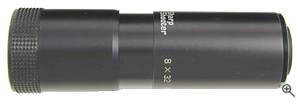
Source: CKC Power website

Cameraid 1.1.4 released!
By Michael Tomkins, The Imaging Resource
(Wednesday, December 27, 2000 - 12:56 EST)
We received an email yesterday from software author Juri Munkki, to let us know of a new version of Cameraid, his Macintosh program for acquiring, viewing, renaming and transforming your digital camera images, as well as creating index web pages and thumbnails. Cameraid 1.1.4 works around certain problems that MacOS 9 caused with certain USB to serial adapters. The update is free to registered users; a fully-functional trial version is available with a cost of $15 to register.
Source: Cameraid website

Digital Outback begins Oly E-10 user review!
By Michael Tomkins, The Imaging Resource
(Wednesday, December 27, 2000 - 12:01 EST)
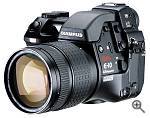 Our good friends over at the Digital Outback Photo website have started a new report over Christmas. The Olympus E-10 Experience Report, still being written, contains numerous examples of images from the E-10, as well as some user opinions on how the camera performs, and its pros and cons... Check it out! Our good friends over at the Digital Outback Photo website have started a new report over Christmas. The Olympus E-10 Experience Report, still being written, contains numerous examples of images from the E-10, as well as some user opinions on how the camera performs, and its pros and cons... Check it out!
Source: Digital Outback Photo

Sunday, December 24, 2000
Season's Greetings from the Imaging Resource!
By Michael Tomkins, The Imaging Resource
(Sunday, December 24, 2000 - 18:08 EST)
Another year, another Christmas! It seems like time flies by these days, as a veritable flood of news, reviews and work keeps both Dave and Mike busy, and to be honest we're having difficulty believing it is that time of year again, but it is. :)
The last year has been a great one for the Imaging Resource, and we continue to receive many kind emails from you, the readers, with thanks, best wishes, and the ever-important suggestions for how to make the site even more useful to you. We'd like to thank all of our readers for supporting the Imaging Resource, and wish you all the very best tidings of the season!
Another handful of days will see us officially entering a new year, and (even if it might seem to have already happened) a new millennium... Perhaps, then, it is appropriate that there seems to be a continuous whirlwind of change, of new products and new solutions to recording our memories. We hope your holidays will be great, and that the camera or accessory you've been wishing for will be under your tree, or in your stocking. Most of all, we hope that you'll enjoy all this technology the way it was intended - have a great end to 2000, an even better start to 2001, and take lots of photos of it all to look back on in years to come!
Happy Holidays from the whole team at the Imaging Resource!

DigitalKamera.de reviews DSC-S70, DSC-F505V!
By Michael Tomkins, The Imaging Resource
(Sunday, December 24, 2000 - 10:32 EST)
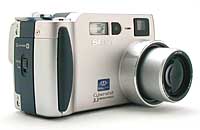 Our friends over at the digitalkamera.de website in Germany have posted two new reviews of late. First up, there's a review of Sony's DSC-S70 digital camera: Our friends over at the digitalkamera.de website in Germany have posted two new reviews of late. First up, there's a review of Sony's DSC-S70 digital camera:"Thanks to its picture quality and extensive accessories the Sony DSC-S70 belongs in the top league of digital cameras. This camera does not offer as many options for manual adjustment (mainly when it comes to exposure control) as its direct competitors from Nikon or Olympus. For example, there is no manual exposure control, only two predefined white balance settings (indoor, outdoor) and no adjustable light sensitivity (at least not as far as the ISO values are concerned). On the other hand the DSC-S70 is often available for a few hundred EUR less than the top-models made by Nikon or Olympus." 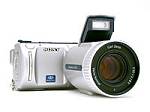 This is followed up by a review of Sony's DSC-F505V digital camera: This is followed up by a review of Sony's DSC-F505V digital camera:"It is difficult to categorise the Sony Cybershot DSC-F505V. Due to its lack of a continuous shooting function and relatively high release delay, the camera is not well suited for sport or action photography, whilst arranging the motif using only the colour LCD screen is too difficult for travel and documentary photography; The DSC-F505V is not suitable for studio photography as well, since it does not come with manual exposure control. Essentially, the DSC-F505V is a digital camera for the more demanding amateur photographer, who places a lot of emphasis on a large zoom range (5x), extendibility (converters, filters, external flash) and the swivel casing concept. The DSC-F505V has a good picture quality, numerous functions, as well as various possibilities for manually adjusting the automatic settings; all of these plus points lift the DSC-F505V above the level of a mere point -and-shoot camera. Thanks to its conspicuous and interesting design it will surely find countless friends. The DSC-F505V's 2.6 Megapixel resolution can still be called up-to-date, though the relatively high price of around 1,100 EUR seems difficult to justify in the age of 3.34 Megapixel digital cameras." Be sure to check out both reviews for the full story, along with images of the cameras themselves and sample photos...

Thursday, December 21, 2000
Lone Star Digital reviews Canon EOS D30!
By Michael Tomkins, The Imaging Resource
(Thursday, December 21, 2000 - 19:19 EST)
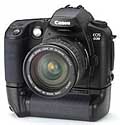 Our friend John Cowley over at the lonestardigital.com website has posted a review of Canon's EOS D30 SLR digital camera. John doesn't have a formal conclusion on his article, but finds a whole lot to like about the D30 (including the lens mount, batteries, hand grip, E-TTL flash metering and more) as well as a few quibbles (no backlight on the top LCD display, quirky focusing in Automatic Selection AF mode, and a slight cyan cast to images). Check it out! Our friend John Cowley over at the lonestardigital.com website has posted a review of Canon's EOS D30 SLR digital camera. John doesn't have a formal conclusion on his article, but finds a whole lot to like about the D30 (including the lens mount, batteries, hand grip, E-TTL flash metering and more) as well as a few quibbles (no backlight on the top LCD display, quirky focusing in Automatic Selection AF mode, and a slight cyan cast to images). Check it out!
Source: Lone Star Digital

Kodak Pro announces Photo Desk image browser!
By Michael Tomkins, The Imaging Resource
(Thursday, December 21, 2000 - 19:12 EST)
 Managing digital image files, says Eastman Kodak Co., has become 'much easier' with the release by the company of a new image browser called Photo Desk. The browser allows users to manage files produced by Kodak Professional DCS 300, 500 and 600 series digital cameras. Managing digital image files, says Eastman Kodak Co., has become 'much easier' with the release by the company of a new image browser called Photo Desk. The browser allows users to manage files produced by Kodak Professional DCS 300, 500 and 600 series digital cameras.
Photo Desk browser software is now available for download from Kodak Professional's website. It shares many of the features of the Kodak Professional DCS Acquire Module and DCS Twain Data Source software, but offers the advantages of a stand-alone application, such as browsing multiple folders and images, and drag-and-drop file management.
In addition, the Photo Desk browser allows users to do the following:- Browse DCS images in folders on hard disks, CD-ROM, PC Cards and network servers using an efficiently laid out contact sheet interface that displays image settings in iconic form.
- Automatically monitor folders and add thumbnails to their display as new images arrive.
- Open multiple images in windows with variable view scaling from 10 to 200 percent.
- Control cropping, rotation, balance, lighting, exposure compensation, look, sharpening and noise reduction.
- Save DCS image files as standard JPEG and TIFF files, with optional naming and sequence numbering.
- Optionally imprint GPS information into images saved in standard TIFF format.
- Automatically open converted files in any application.
- Copy and paste image settings.
- Drag and drop images between folders.
- Add image information, including IPTC-NAA record 2.
Photo Desk for Mac requires a Power PC-based Macintosh computer with a G3 or better processor, 64Mb of RAM allocated to Photo Desk (96Mb recommended), 200 Mb of free disk space and Mac OS 8.6 or greater. PhotoDesk for PC requires Windows/Intel PC with a 266 MHz Pentium II or better processor, 128 MB of RAM allocated to Photo Desk (256 MB recommended), 200 MB of free disk space and Windows 98 Second Edition, Windows Millennium, Windows NT 4.0 or Windows 2000.

Olympus offers free SmartMedia ZiO! with D-490Z!
By Michael Tomkins, The Imaging Resource
(Thursday, December 21, 2000 - 18:21 EST)
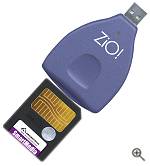 Microtech Int'l. Inc. has today announced a special promotion with Olympus America Inc that, for a limited time, will see Olympus offering a free Microtech SmartMedia ZiO! card reader with the purchase of a D-490 Zoom Digital Camera. Microtech Int'l. Inc. has today announced a special promotion with Olympus America Inc that, for a limited time, will see Olympus offering a free Microtech SmartMedia ZiO! card reader with the purchase of a D-490 Zoom Digital Camera.
The ZiO reader is compatible with SmartMedia cards up to 64MB, and the free offer adds to the D-490's bundle which already includes 2 Olympus CR-3V Lithium batteries, an 8MB Olympus SmartMedia card, strap, serial cable for Mac and PC, video connection cable for TV or VCR, Olympus Camedia Master Utility Software for downloading images from the camera, and instruction manuals.
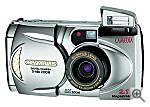 Microtech's SmartMedia ZiO! will be offered to purchasers of the Olympus D-490 Zoom from November 1, 2000 - February 28, 2001. The promotion will be fulfilled via a mail-in coupon, which will be provided inside the Olympus retail package. Microtech's SmartMedia ZiO! will be offered to purchasers of the Olympus D-490 Zoom from November 1, 2000 - February 28, 2001. The promotion will be fulfilled via a mail-in coupon, which will be provided inside the Olympus retail package.
Source: Yahoo! Finance / Business Wire

Wednesday, December 20, 2000
LaserSoft announces Silverfast SE and DC-SE!
By Michael Tomkins, The Imaging Resource
(Wednesday, December 20, 2000 - 8:35 EST)
 LaserSoft Imaging, developer of imaging software SilverFast Ai, has announced SilverFast SE and SilverFast DC-SE as the simplified versions of SilverFast Ai for the low-end market. Costing $49, SilverFast SE is designed to work with all major scanners while SilverFast DC-SE is designed for all digital cameras. LaserSoft Imaging, developer of imaging software SilverFast Ai, has announced SilverFast SE and SilverFast DC-SE as the simplified versions of SilverFast Ai for the low-end market. Costing $49, SilverFast SE is designed to work with all major scanners while SilverFast DC-SE is designed for all digital cameras.
LaserSoft claims that images will "especially benefit from SilverFast's intelligent auto-adjust and LAB-Unsharp masking, which does not sharpen the colour noise of single channels, but instead only sharpens the image's edges effectively. SilverFast SE/DC-SE's real-time processing preview with the embedded intelligence from high end colour reproduction offers the user an intuitive and professional approach securing maximum image quality."
SilverFast SE/DC-SE contains the major highlights of SilverFast Ai, such as:- Real-Time Correction
- Auto-adjust with Artificial Intelligence
- Unsharp Masking
- Color Cast Removal Slider
- Selective Color Correction
- RGB-TIFF and JPEG output formats
SilverFast SE/DC-SE's ScanPilot guides the novice user through steps to correct their images. In addition to these features SilverFast DC-SE can show and print all images in the Picture Overview. SilverFast DC-SE can also be upgraded to SilverFast DC or SilverFast DC Pro with SilverFast IT8-Calibration and the SilverFast JobManagement. This would allow batch correction and processing multiple images on the fly.
SilverFast SE/DC-SE is available for Apple Macintosh OS, Windows 95, 98, NT, 2000 and ME and will be available shortly from LaserSoft Imaging's web site. (The press release notes that the software should be available today, however at the time of this writing we didn't see anywhere to download it from...)
Source: Yahoo! Finance / Canada NewsWire

IC Media announces two new single-chip cameras!
By Michael Tomkins, The Imaging Resource
(Wednesday, December 20, 2000 - 8:20 EST)
IC Media Corp. has introduced two new chips that it says "provide the industry's highest level of camera integration". As well as the CMOS image sensor and analog-to-digital converter functions, IC Media's chips include all of the digital color image processing capabilities.
The ICM-205D VGA-resolution (640x480 pixels) single-chip camera, targetted at digital camcorders or digital still cameras as well as cameras integrated into cellular phones and PDAs, outputs RGB or YUV color data in 8- or 16-bit digital format.
The ICM-512D CIF-resolution (360x244 pixels) single-chip camera is aimed at security cameras, toys, wireless cameras and other monitoring systems that use TVs for image display. It is claimed to be the first single-chip camera that provides both analog and digital output. While displaying analog signals on the TV, the chip can output digital images for encoding and transferring across the Internet or a modem. IC Media notes that other single-chip cameras either provide digital or analog output, but not both."Currently, the possibilities for digital camera applications are exploding, and we're proud to be leading the race with the true single-chip cameras," stated Jim Li, Executive Vice President, IC Media Corporation. "The biggest challenges in integrating all of these functions onto a single chip have been reducing the noise and improving the yield. We developed proprietary techniques to overcome these obstacles." Both chips integrate color image processing capabilities normally found on a separate chip, including color interpolation, white balancing and color correction, gain control, Gamma correction, exposure control, color space conversion, and output formatting. IC Media's ICM-205D VGA-resolution single-chip camera can operate at 30, 15 or 10 frames per second for digital camcorders. Produced in 0.5-micron CMOS technology, the ICM205D uses a 1/3" optical system. Pixel size is 8.0-micron x 8.0-micron, giving a sensor area of 5.1 mm x 3.8 mm. The chip includes a 9-bit ADC (analog-to-digital converter) that performs correlated double sampling to improve image quality. The ICM-512D CIF resolution single-chip camera meanwhile includes an NTSC encoder module. Produced in 0.5-micron CMOS technology, the ICM-512D operates at 30 frames (60 fields) per second. With a pixel size of 8.9-micron x 9.8-micron, the ICM-512D has a sensor area of 3.2 mm x 2.4 mm for a 4:3 aspect ratio. The chip includes a 9-bit ADC that performs correlated double sampling to improve image quality.
The ICM-205D single-chip VGA camera is priced at $30 in quantities of 1,000. It is available now in production quantities in a 48-pin plastic LCC package. The ICM-512D single-chip CIF camera is priced at $20 in quantities of 1,000. It is available now in production quantities in a 48-pin ceramic LCC package.
At the time of this writing, the IC Media website was uncontacteable.
Source: Yahoo! Finance / Business Wire

AOL and Kinko's announce promotion!
By Michael Tomkins, The Imaging Resource
(Wednesday, December 20, 2000 - 8:09 EST)
 Building upon their existing strategic alliance, Kinko's has announced an integrated campaign with America Online Inc. designed to build awareness for Kinko's digital photo printing capabilities and AOL's 'You've Got Pictures' service. The promotion encourages existing AOL members to print out a complimentary, 8" x 10" print from any image in their 'You've Got Pictures' account, using an Internet-connected KODAK PictureMaker kiosk at a participating Kinko's branch. Building upon their existing strategic alliance, Kinko's has announced an integrated campaign with America Online Inc. designed to build awareness for Kinko's digital photo printing capabilities and AOL's 'You've Got Pictures' service. The promotion encourages existing AOL members to print out a complimentary, 8" x 10" print from any image in their 'You've Got Pictures' account, using an Internet-connected KODAK PictureMaker kiosk at a participating Kinko's branch.
Leveraging the online and offline assets of both companies, the new initiative will be marketed through a variety of channels including the AOL service and kinkos.com homepage, where the special promotion will be prominently displayed with direct links to the 'You've Got Pictures' jump page. Members will also be alerted of this promotion through the monthly 'You've Got Pictures' electronic newsletter.
In addition, point-of-purchase coupon signage will be displayed at the more than 700 Kinko's branches where the KODAK PictureMaker kiosks are available. Kinko's notes in its press release that it is "the only retailer in the United States to have at least 700 locations where photo kiosks are networked to the outside world - easily enabling customers to access AOL's 'You've Got Pictures,' a joint AOL and KODAK initiative, while in a Kinko's store."
 AOL members can obtain printable coupons on AOL (AOL Keyword: Kinko's Offer) and Kinko's Web sites, as well as at participating Kinko's stores. For consumers who aren't AOL members, free AOL 6.0 CD-ROM discs will be available to customers at participating Kinko's locations. Up to a $6.99 value, the Kinko's and AOL 'You've Got Pictures' promotion ends January 31, 2001. AOL members can obtain printable coupons on AOL (AOL Keyword: Kinko's Offer) and Kinko's Web sites, as well as at participating Kinko's stores. For consumers who aren't AOL members, free AOL 6.0 CD-ROM discs will be available to customers at participating Kinko's locations. Up to a $6.99 value, the Kinko's and AOL 'You've Got Pictures' promotion ends January 31, 2001."Our partnership with America Online and its 'You've Got Pictures' services was created to help effectively educate consumers of the benefits of online digital imaging, and convey that the Kinko's brand has expanded into the digital photography market with its array of photographic services. Working with AOL is an example of highly integrated 'clicks and bricks' marketing that gives both brands the opportunity to interact with and educate their own and each other's customers," explained Laura Kurzu, vice president of marketing, Kinko's Inc.
"America Online is pleased to expand on our existing relationship with Kinko's. Like Kinko's, we're always seeking ways to offer our members new and exciting products and services. This promotion is a great example of how we are utilizing the alliance that we announced earlier this year to serve our customers both online and offline, and market our respective brands through new channels," said Sheila Leverone, vice president of strategic businesses, America Online, Inc.
Source: Yahoo! Finance / Business Wire

Print@Kodak licenses CardStore greeting card service!
By Michael Tomkins, The Imaging Resource
(Wednesday, December 20, 2000 - 7:38 EST)
 CardStore.com has announced an agreement with Eastman Kodak Company for the launch of a card service for Kodak's Print@Kodak Internet photofinishing service. Under the agreement, users visiting the Print@Kodak service will be able to create, personalize and mail custom-printed greeting cards and photo cards. The CardStore.com ASP solution gives consumers who use Print@Kodak the ability to upload digital pictures to create family photo cards -- with next-day printing and mailing to a user's entire address book. CardStore.com has announced an agreement with Eastman Kodak Company for the launch of a card service for Kodak's Print@Kodak Internet photofinishing service. Under the agreement, users visiting the Print@Kodak service will be able to create, personalize and mail custom-printed greeting cards and photo cards. The CardStore.com ASP solution gives consumers who use Print@Kodak the ability to upload digital pictures to create family photo cards -- with next-day printing and mailing to a user's entire address book."With the exploding growth of digital camera sales, consumers will be looking for new and creative ways to share their digital pictures -- both online and offline," said Jinee Tao, CEO and co-founder of CardStore.com. "We are delighted to be working with Kodak to provide a photo card service for Print@Kodak." Users of Print@Kodak can now upload digital pictures, select from a variety of borders, and write their own greetings to create a personalized card that's mailed the next day."Our goal is to give consumers easy and innovative ways to take, make and share better pictures," said Nancy Carr, vice president, Digital and Applied Imaging, Eastman Kodak Company. "CardStore.com lets us add an easy-to-use application for people to create and share real cards using their personal digital pictures." Under the agreement, CardStore.com is offering Kodak its standard ASP card service. The CardStore.com co-branded card service provides a way to select, customize and mail cards to one person or thousands. Visitors can send card mailings from their desktop in minutes for a variety of applications including holiday and photo greeting cards, party invitations, birthday cards, birth, engagement and wedding announcements, anniversary parties and other occasions. Users may upload their customer mailing lists from standard software (Excel, Outlook, Palm) and store them on site for easy access. CardStore.com prints and mails on the next business day using premium cover stock, commercial quality digital printing, "elegant penmanship fonts", quality envelopes and real first-class stamps.
Source: Yahoo! Finance / Business Wire

Tuesday, December 19, 2000
Minor updates to Bibble, Qimage Pro!
By Michael Tomkins, The Imaging Resource
(Tuesday, December 19, 2000 - 13:54 EST)
We spotted this morning that there have been updates to two excellent imaging utilities which we mention often on this page - Bibble and Qimage Pro. Bibble, which yesterday was updated to version 2.4, has had a minor update to v2.4a, correcting two problems. The first fix is to an install problem with the plugin under 2.4, and the second fixes rotation with the plugin...
Qimage Pro, meanwhile, has had three minor updates since we last mentioned it on December 5. Qimage Pro v10.31 had the following changes:- Sharper prints: Improved interpolation algorithms result in even sharper prints with better contrast than ever.
- Startup validation: Qimage Pro can now detect corrupted startup settings and reset to default values. Now if you get an error starting Qimage Pro and are unable to run the software, just run Qimage Pro a second time and it will detect where the failure occurred and will allow you to reset program settings for only the affected group of parameters. This eliminates the need to manually delete corrupted parameter files (like qimage.ini and qimage.prn) and puts an end to unrecoverable startup errors due to invalid settings.
- Bug fix: Fixed a bug that was causing "divide by zero" errors under certain printing conditions.
v10.32 had one change, a printer settings fix which restored Qimage Pro's ability to remember printer settings from the last session. Finally, v10.33, the current version, adds an enhancement for Fuji S1 Pro owners. Qimage Pro can now display Fuji S1 camera settings for Color, Tone and Sharpness when reading EXIF info from original images...

Monday, December 18, 2000
Silicon Film's EFS-1 - question and answer!
By Michael Tomkins, The Imaging Resource
(Monday, December 18, 2000 - 16:05 EST)
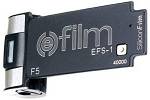 We mentioned in our news item "Silicon Film posts EFS-1 sample photos!" of last Friday that we'd been in contact with Silicon Film, the company behind the interesting (and long-awaited) digital film cartridge that promises to give certain film cameras a subset of digital camera functionality, and promised at that time to answer a few more questions we've seen asked as to how exactly the cartridge operates. Silicon Film Co-Founder and Senior VP of Marketing and Sales, Bruce Totty, kindly responded and filled us in a little on the (e)film and how it works: We mentioned in our news item "Silicon Film posts EFS-1 sample photos!" of last Friday that we'd been in contact with Silicon Film, the company behind the interesting (and long-awaited) digital film cartridge that promises to give certain film cameras a subset of digital camera functionality, and promised at that time to answer a few more questions we've seen asked as to how exactly the cartridge operates. Silicon Film Co-Founder and Senior VP of Marketing and Sales, Bruce Totty, kindly responded and filled us in a little on the (e)film and how it works:
Imaging Resource: How fast will the (e)film cartridge be able to take photos, and if this is a burst speed, for how many photos will the burst last?
Bruce Totty: The (e)film cartridge is better described as a consecutive shot device. We are able to capture an image approximately every other second. We can store 24 raw, uncompressed, images in the 64 Mbytes of flash inside the cartridge.
Imaging Resource: How does the cartridge signal to the user that it is ready to take a photo?
Bruce Totty: The (e)film cartridge will provide an audible beep to signal the photographer that the (e)film is busy processing and did not capture the last shot. The (e)film will then audibly signal the photographer with a different sound that it is ready to shoot again.
Imaging Resource: How does the (e)film cartridge signal that it is full?
Bruce Totty: The photographer will be notified by an audible signal and also on the (e)film LCD, viewable through the camera back window. The LCD provides (e)film status, shot count, battery condition and other system mode information.
Imaging Resource: Is the (e)film cartridge sensitive to IR wavelengths, i.e. is it suggested to use a hot mirror filter with (e)film for optimum image quality and also is it capable of taking IR photos with an appropriate filter?
Bruce Totty: The (e)film has multiple coatings on the optical surfaces including an IR filter. These coatings limit the pass of IR wavelengths to the sensor, which precludes IR photography but optimizes traditional photography. We recommend photographers use traditional film in their cameras for IR photography. We expect photographers to try a variety of filters and shooting modes with (e)film. We look forward to their creativity.
Imaging Resource: How long an exposure can the (e)film cartridge allow? Assuming that it is limited to a certain length of exposure, does the cartridge indicate in any way when it has finished the exposure when the camera is in bulb mode?
Bruce Totty: The (e)film can operate down to 1/15th of second. We don't recommend bulb mode. If the photographer does operate in bulb mode, the image may be degraded. The (e)film will not notify the photographer of this condition. Our user manual will define the recommended shooting conditions and modes.
Imaging Resource: What environmental range can the (e)film cartridge be used or stored in (temperature, humidity)?
Bruce Totty: The (e)film has been designed to operate in the same conditions as digital cameras.
Thanks to Bruce for taking the time to answer our questions... If any readers have questions about the Silicon Film EFS-1 system, drop Mike an email and we'll try to get them answered for you!
Source: Silicon Film website

New version (v2.4) of Bibble released!
By Michael Tomkins, The Imaging Resource
(Monday, December 18, 2000 - 15:44 EST)
Eric Hyman, the man behind the excellent imaging utility Bibble, has released a new version of the program over the weekend. Bibble v2.4 extends support for the Canon EOS D30's .CRW CCD-RAW files, adds the capability to open Nikon D1 JPEG files in PhotoShop using Bibble's options, improves interpolation, and fixes a number of bugs. Sadly for PowerShot G1 owners (like Mike!), Bibble can't currently process G1 .CRW files because of the way Canon's drivers work...
Here's a full list of changes:- *NEW* Ability to load D1 Jpegs in Photoshop using Bibble's options Just like .nefs
- *NEW* Ability to load D30 .crw's in Photoshop using Bibble's options.
- *NEW* Improved interpolation method for better quality (less fringing, better color)
- *NEW* D30 .crw files can be read and browsed even without the .thm files.
- Added Cropping to resample dialog. (Will add to batches later)
- Fixed problem with Tethered Numbering.
Fixed problem with Tethered File overwriting. - Fixed Colorspace problem with saving 8-bit tiffs.
- Fixed crash with invalid monitor profiles.
- Fixed problems leading to occasional inconsistent options.
- Fixed Crash with Monitor mode. Disallow monitor entry by typing. Enable selection anytime.
- Fixed a variety of small memory leaks that could add up to a crash with big batches.
- Fixed a few crashes related to the noise options.
- Fixed crash loading .crw if .thm was not present.
- D30: Instant previews for crw Files.
- Fixed problem with D30 batches being black with preview off.
- Fixed File operations on .crw files (Copy, Move, etc) also effect .thm files
If you're a Nikon D1 or Canon EOS D30 owner, you owe it to yourself to try Bibble out... Visit the Bibble Labs website to download the current version.
Source: Bibble Labs website

Saturday, December 16, 2000
Nikon D1 .NEF - an educational look at raw files!
By Michael Tomkins, The Imaging Resource
(Saturday, December 16, 2000 - 13:47 EST)
A note from Uwe Steinmuller over at the Digital Outback Photo website points us towards an interesting new item on his site. Daniel Stephens is currently authoring the item, the first part of which has been published, looking at the .NEF raw file format used in Nikon's D1 digital camera. Daniel is attempting to decode the format himself to create a .NEF converter for the Linux operating system, and the process is proving to be quite enlightening on just how exactly a digital camera works. Check it out!
Source: Digital Outback Photo

Friday, December 15, 2000
Remote Reality announces new OneShot360!
By Michael Tomkins, The Imaging Resource
(Friday, December 15, 2000 - 18:56 EST)
 RemoteReality Corp. has announced the availability of its next generation OneShot360 Immersive Picture System that the company says offers "a faster, simpler and more cost effective alternative for enhancing Web content with 360-degree digital imagery". The new OneShot360, replacing an older version we first told you about last July, enables businesses that rely heavily on visual images such as real estate, sports, and travel and tourism, to capture 360-degree views that enable viewers to then create custom perspectives. RemoteReality Corp. has announced the availability of its next generation OneShot360 Immersive Picture System that the company says offers "a faster, simpler and more cost effective alternative for enhancing Web content with 360-degree digital imagery". The new OneShot360, replacing an older version we first told you about last July, enables businesses that rely heavily on visual images such as real estate, sports, and travel and tourism, to capture 360-degree views that enable viewers to then create custom perspectives."The Internet provides a powerful viewing medium for the marketing and promotion of real estate, especially with the availability of virtual tours," said Richard Huff, CEO of Access Technology Services and ImageMaker360. "Our decision to work with RemoteReality’s OneShot360 was primarily driven by customer demand for both high quality images and excellent services. By combining RemoteReality’s high-quality virtual tour technology with ImageMaker360’s customer-centric service model, we can offer a solution that goes beyond what was available in the market until now – a simple, low-cost and fast alternative for immersive images." Improvements to the OneShot360 include a range of feature-rich functions and information on how to best capture space and enhance immersive images with HotSpots and Internet links, making users more productive in less time. In addition to an improved design that is more durable and ergonomic, new software enhancements have been added, including:- Email capabilities: The OneShot360 now offers the ability to email immersive images. Customers, friends, family and colleagues can view the 360-degree immersive images without any plug-ins.
- Additional viewer support: The addition of IBM HotMedia and Apple QuickTime image viewers give customers additional options for viewing immersive imagery.
- Interactive effects: Through a partnership with IBM’s HotMedia Group, RemoteReality content can be enhanced with the addition of hot spots, offering Web designers an end-to-end solution for adding images and links to other Web sites
- Image enhancements: The new OneShot360 provides users the ability to adjust contrast and brightness. Additionally, users have the ability to adjust both the quality and resolution of images.
"Today’s Web is populated with visual content that was not designed to take advantage of what the Internet has to offer. RemoteReality enables businesses to develop visual content more suited to the interactive character of the Web, and the OneShot360 is a critical part of this plan,” said Jeb Hurley, president and CEO of RemoteReality. “The latest version of the OneShot360 is proof of our commitment to offering customers and partners simple and easy-to-use technologies that can quickly create immersive content that will enhance the value of their visual information and differentiate their site and their offerings.” The next generation OneShot360 is available now from RemoteReality and their reseller partners. The retail price of the OneShot360 is $798. At the same time, RemoteReality announced a preview of an upcoming enhancement to OneShot360. Available in Q1 2001, the OneShot360 Plus will add the capability of capturing full 360� x 360� images for interactive virtual tours on the Web. Current owners of OneShot360 systems will be able to purchase an option that will add this new capability to their systems."While most 360� applications are easily addressed with our patented OneShot360 technology, there are some applications, such as architectural photography and commercial real estate, that will benefit from occasional use of a full 360� x 360� image. For these applications, we are enhancing our OneShot360 system to capture full spherical images," says Jeb Hurley, president and CEO of RemoteReality. "With this new capability, the OneShot360 product family meets all of our customers’ immersive imaging needs, including fast images requiring only a single shot and full spherical images when needed. No other company provides this application breadth in their product line."
Source: Remote Reality website

Silicon Film posts EFS-1 sample photos!
By Michael Tomkins, The Imaging Resource
(Friday, December 15, 2000 - 17:48 EST)
 Yesterday afternoon, we posted a lengthy article discussing the imminent arrival of Silicon Film's EFS-1, a cartridge designed to add digital functionality to certain 35mm SLR film cameras, in our news item "Silicon Film's Electronic Film System nearing market?"... After a conversation with Silicon Film's Bruce Totty, we were told that one of our main questions about the EFS-1 system would be answered today - that of image quality. True to their word, Silicon Film have now posted 14 sample images taken with the system. Note, though, that these images are subject to the usual proviso - they were taken with a development version of the system and similarly to development cameras, much work goes into fine-tuning the performance at this stage. Hence these images are likely not fully representative of what can be expected from the EFS-1 system, and instead represent a baseline that the system should be able to match or better... Yesterday afternoon, we posted a lengthy article discussing the imminent arrival of Silicon Film's EFS-1, a cartridge designed to add digital functionality to certain 35mm SLR film cameras, in our news item "Silicon Film's Electronic Film System nearing market?"... After a conversation with Silicon Film's Bruce Totty, we were told that one of our main questions about the EFS-1 system would be answered today - that of image quality. True to their word, Silicon Film have now posted 14 sample images taken with the system. Note, though, that these images are subject to the usual proviso - they were taken with a development version of the system and similarly to development cameras, much work goes into fine-tuning the performance at this stage. Hence these images are likely not fully representative of what can be expected from the EFS-1 system, and instead represent a baseline that the system should be able to match or better...
We also asked Silicon Film a number of specific questions about the EFS-1 system such as, for example, the burst-mode performance of the device, which we hope to have answers on for our readers later today. In the meantime, check out the sample images! (Note that the image thumbnails themselves link to resized versions - the originals can be accessed by clicking on the "full size JPG" link under each thumbnail...)
Source: Silicon Film website

Nihon Keizai Shimbun reports on Japanese digicam production!
By Michael Tomkins, The Imaging Resource
(Friday, December 15, 2000 - 17:32 EST)
 A news item from the Japanese Nihon Keizai Shimbun newspaper reproduced by Nikkei BP Network's AsiaBizTech website predicts that digital camera shipments from 19 Japanese manufacturers should reach 12 million units worldwide this year, double the number sold last year. The figure is predicted to surpass 20 million units in 2001... A news item from the Japanese Nihon Keizai Shimbun newspaper reproduced by Nikkei BP Network's AsiaBizTech website predicts that digital camera shipments from 19 Japanese manufacturers should reach 12 million units worldwide this year, double the number sold last year. The figure is predicted to surpass 20 million units in 2001...
Sony, Olympus and Fuji together hold 70% of the global digicam market, 25% each for Sony and Olympus and 20% for Fuji. The item notes projections from the three companies that show that Sony and Olympus plan to double shipments next year to 5 million cameras each, while Fuji plans a 70% increase to 4.8 million cameras. Canon Inc. meanwhile plans to triple shipments to 3 million camera, and Kodak digicam manufacturing subsidiary Chinon intends to increase shipments 50% to 2 million units. Kodak will also get a boost from some 100,000 cameras monthly being manufactured on an OEM basis for the company by Sharp. Finally, Nikon plans a 70% increase to 1.2 million units globally.
To meet demand spurred by digital camera growth, Sony intends to invest ¥10 billion (US$89.2 million) in boosting its production facilities of CCD image sensors, and semiconductor manufacturers are planning to boost production of flash memory. Film camera shipments, meanwhile, have apparently flattened at 34 million in 1999.
Source: Nikkei Business Publications' AsiaBizTech

USB 2.0 vs FireWire: vendors reveal plans!
By Michael Tomkins, The Imaging Resource
(Friday, December 15, 2000 - 15:02 EST)
 An interesting news item from MacCentral looks at the future of USB 2.0 and FireWire (otherwise known as IEEE1394) on the Apple Macintosh platform, mentioning plans from several digicam vendors in the process... An interesting news item from MacCentral looks at the future of USB 2.0 and FireWire (otherwise known as IEEE1394) on the Apple Macintosh platform, mentioning plans from several digicam vendors in the process...
Apple, which originally developed FireWire and charges significant licensing fees for use of the technology, faces a dilemma with USB 2.0. Does the company add support for USB 2.0 to its computers - which already support the low speed USB standard - or does it stick with FireWire as the standard for high-speed connectivity on the Mac? Do the former, and the company risks eroding the perceived value of its FireWire connectivity; do the latter and Macintosh users will be shut off from the benefits of a likely flood of USB 2.0 devices appearing late in 2001 (they'll be able to use them, but only at USB 1.1 speeds, since the standard has been designed to allow compatibility in both directions).
The item reveals some USB 2.0 plans from digital imaging companies as follows:- Epson plans to have USB 2.0 in some products from summer/fall 2001
- Minolta is considering offering a digital camera with USB 2.0 connectivity in Spring 2002 at the earliest. The company is considering adding high-speed connectivity to its Dimage Scan Dual II film scanner, but is likely to go for FireWire here, adding USB 2.0 options once the standard catches on...
- Kodak doesn't currently see a need for USB 2.0, noting that it is waiting to see what Apple does before making a decision. The company currently sells 10-12% of its digital cameras to Mac users, and doesn't want to alienate this market. One option the company is considering is to put both FireWire and USB 2.0 connectivity into its cameras...
- Canon USA's Chuck Westfall is not currently aware of any products planned to be available before Summer 2001 with USB 2.0 support. Beyond that timescale, Canon Japan will most likely be making the decisions...
In the meantime, Apple's strategy seems to be that FireWire is all that is needed for high-speed connectivity, even as numerous manufacturers are likely considering USB 2.0 since their is minimal cost involved in uprating existing USB 1.1 designs to the new standard. Either way, it seems that USB 2.0 is still 6-12 months away, giving Apple plenty of time to consider its position...
Source: Yahoo! News / MacCentral

DCRP reviews three photo printers!
By Michael Tomkins, The Imaging Resource
(Friday, December 15, 2000 - 13:22 EST)
 Our good friend Jeff Keller over at the Digital Camera Resource Page has posted a combined review of three photo printers, the Epson Stylus Photo 1270, Kodak Personal Picture Maker 200 and Olympus P-400 on his site. According to Jeff, this will be his last review of the year - here's the summary: Our good friend Jeff Keller over at the Digital Camera Resource Page has posted a combined review of three photo printers, the Epson Stylus Photo 1270, Kodak Personal Picture Maker 200 and Olympus P-400 on his site. According to Jeff, this will be his last review of the year - here's the summary:"If you can afford the upfront and continuing costs of owning a dye sublimation printer, then the Olympus P-400 printer. The output is truly amazing and it will (supposedly) last a very long time. The main downsides here is the cost -- oh, and I sure wish that LCD was color.
The Epson printers are very nice as well -- and once they get their act together with their paper, you can be confident that your prints will last for many years to come. If you don't care about having a standalone printer, I'd strongly recommend any of the Epson Stylus Photo printers.
The Kodak PM200 surprised me -- I wasn't expecting much, but I really liked using it in standalone mode. The photo quality is the worst of the bunch, but it's still very good. The ability to use it without a computer is handy for many folks, and it's easy to use -- and how about that color LCD. The downside here is that it's not (yet) Mac or Windows ME compatible, and it's pretty slow too. Be sure to check out the full review for the whole story...
Source: Digital Camera Resource Page photo-printer showdown

The Ultimate Digi-Photo Christmas Gift?
By Michael Tomkins, The Imaging Resource
(Friday, December 15, 2000 - 12:58 EST)
 We've just posted our full review of the Kodak Smart Picture Frame! This was an interesting product for us to review. Dave (who wrote the "majority opinion" ;-) started out with a real prejudice against the whole concept of an internet-connected picture frame. "Hmph," he said, "Another $350 yuppie photo gadget." After actually playing with it a bit though, he ended up liking it so much that he bought one for his wife for Christmas. (It's OK, Marti doesn't read this page. :-) We've just posted our full review of the Kodak Smart Picture Frame! This was an interesting product for us to review. Dave (who wrote the "majority opinion" ;-) started out with a real prejudice against the whole concept of an internet-connected picture frame. "Hmph," he said, "Another $350 yuppie photo gadget." After actually playing with it a bit though, he ended up liking it so much that he bought one for his wife for Christmas. (It's OK, Marti doesn't read this page. :-)
You'd have to understand just how overloaded/saturated with digital photo technology Dave is to comprehend how strong an endorsement it is that he'd go out and actually spend hard-earned money on something like this. The neat thing with the Smart Picture Frame is the way it transports your photos out of the computer and directly onto the table, counter, shelf, or desk of whoever you're sharing them with. Have out-of-state grandparents, other relatives, or a close friend? This is the gift for them!
As you'll gather from Dave's comments in the review, we liked this a lot, but as we see it, Kodak has three obstacles to overcome with it. 1) Price: At $350 a pop, it's a significant investment for many people. 2) Conveying the "cool" factor: It's pretty hard to imagine what this is like until you actually play with one. Tough marketing job for Kodak. 3) Setup: No two ways around it, getting the Smart Picture Frame running the first time was a pain. (Might be easier elsewhere than Atlanta, where a lack of local access numbers seemed to pose some problems for our initial setup.) A big hill to climb, but if Kodak can really get the word out on these, we think they'll be very successful. Check it out!
Source: The Imaging Resource Kodak Smart Picture Frame review

Thursday, December 14, 2000
Kodak updates RFS 3600 drivers!
By Michael Tomkins, The Imaging Resource
(Thursday, December 14, 2000 - 18:52 EST)
 An updated version of host software for the Kodak Professional RFS 3600 film scanner is now available from Kodak's website, a press release reports. The upgrade includes such enhancements as a wider selection of film terms and improved control sensitivity. An updated version of host software for the Kodak Professional RFS 3600 film scanner is now available from Kodak's website, a press release reports. The upgrade includes such enhancements as a wider selection of film terms and improved control sensitivity."The RFS 3600 has been an extremely popular product right from its introduction this fall," said Donald Pillittere, Worldwide Product Manager, Scanner Products, Kodak Professional. "Now - just a few months after bringing it to market and based on input from our customers - we've made it even better and easier to use." In addition to new film terms, Version 1.1 of the host software provides improved memory management, increased stability on Macintosh computers, and enhanced low-resolution scan performance. Besides correcting some minor problems and anomalies found in the original host drivers, the new software adjusts the sensitivity of Color Balance and Levels & Curves controls, making minor image adjustments with these tools easier.
The update, which is designed for Macintosh and Windows 98 SE, NT 4.0 and 2000 systems, is available now and can be downloaded from Kodak's drivers site. It also is designed for improved installation on
Japanese operating systems.
Kodak Professional is also adding a Portuguese-language user's manual for the scanner, which is included on the software CD accompanying all new scanners and is downloadable from the Kodak web site for current owners.

Cybernet bundles Dolphin cam for gesture recognition!
By Michael Tomkins, The Imaging Resource
(Thursday, December 14, 2000 - 18:12 EST)
 Cybernet Systems today announced the general availability of UseYourHead Plus, a retail pack that combines Cybernet's gesture recognition technology software, UseYourHead, with a USB PC digital camera by Dolphin Peripherals, makers of the 007 digital pocket camera. The combination pack makes it easier for PC gamers who presently don't own a USB PC camera to immediately install and enhance their game play experience with UseYourHead software. Cybernet Systems today announced the general availability of UseYourHead Plus, a retail pack that combines Cybernet's gesture recognition technology software, UseYourHead, with a USB PC digital camera by Dolphin Peripherals, makers of the 007 digital pocket camera. The combination pack makes it easier for PC gamers who presently don't own a USB PC camera to immediately install and enhance their game play experience with UseYourHead software."Putting UseYourHead with Dolphin's iCAM USB digital camera creates an all-in-one PC gaming enhancement package that's convenient for the customer," noted Anthony Comazzi, vice president of business development at Cybernet Systems. "Many PC game players may not already own a USB PC camera, which is required -- along with UseYourHead software -- to use your head as an additional game command device. UseYourHead Plus provides users with all of the components in one retail box to start having more fun playing a variety of PC games."  The UseYourHead Plus pack includes the USB iCAM from Dolphin Peripherals, which has a 100K CMOS image sensor supporting a resolution of 352 X 288 (CIF) and processes up to 30 frames per second. It is the first time a Dolphin Peripherals product has been integrated as a part of a complete retail solution, although the company has several OEM products marketed under other brand names. The UseYourHead Plus pack includes the USB iCAM from Dolphin Peripherals, which has a 100K CMOS image sensor supporting a resolution of 352 X 288 (CIF) and processes up to 30 frames per second. It is the first time a Dolphin Peripherals product has been integrated as a part of a complete retail solution, although the company has several OEM products marketed under other brand names."The iCAM camera is a perfect match for Cybernet's innovative software," said Dolphin Peripheral's chairman Todd Waldman. "Packaging UseYourHead with one of our web cams provides us with a unique opportunity to be a part of an exciting new technology." UseYourHead Plus is being distributed by Macmillan USA to retail outlets throughout the U.S. for a street price of $79.99, which includes a limited time rebate offer.
UseYourHead is a program that works in conjunction with a USB PC digital camera to track a player's head movements, translating these movements into game commands. For instance, when using the software with a flight simulator program, your head movements command the plane up, down, left and right, freeing your hands for other keyboard commands. Using one's head as an additional game command device adds a new dimension to playing PC games such as flight simulation, adventure, children's, edutainment games, and first and third person shooter games.
Source: Yahoo! Finance / Business Wire

Digital Foto adds digital camcorder coverage!
By Michael Tomkins, The Imaging Resource
(Thursday, December 14, 2000 - 16:39 EST)
 DigitalFOTO magazine has announced the launch of a new section dedicated to digital video starting with the April 2001 issue. The new section, MOVINGPictures, features the newest digital video products, video shooting and editing tutorials, profiles of digital video pros, and news on the latest technology, the magazine says. DigitalFOTO magazine has announced the launch of a new section dedicated to digital video starting with the April 2001 issue. The new section, MOVINGPictures, features the newest digital video products, video shooting and editing tutorials, profiles of digital video pros, and news on the latest technology, the magazine says."Anyone looking to buy a DV camcorder, everyone who already owns one, or any photographer who has a digital camera with built-in movie capability will find useful information about this burgeoning market in MOVINGPictures," states Nikki Echler, digitalFOTO's editor-in-chief. The MOVINGPictures section was created in response to letters from readers unsure of which type of camera to buy: a digital video recorder with still capabilities or a still digital camera with video capabilities. MOVINGPictures will cover the merging technologies with articles covering both types of cameras. The articles will be written from the photographer's viewpoint, and will focus on teaching people how to get more out of the equipment they already have or are planning to purchase."It is a natural progression for us to begin reporting on digital video because of the increasing popularity of DV cameras and their ability to produce digital still photographs," states Kevin White, digitalFOTO's publisher. "MOVINGPictures is designed to satisfy our readers' interest in this new technology, and to offer new marketing opportunities for the digital video market."
 Kris Fong, digitalFOTO's associate editor adds, "In addition to the MOVINGPictures section, we will support up-and-coming digital video producers by including their video clips on the CD-ROM that we regularly distribute with the magazine." Kris Fong, digitalFOTO's associate editor adds, "In addition to the MOVINGPictures section, we will support up-and-coming digital video producers by including their video clips on the CD-ROM that we regularly distribute with the magazine." digitalFOTO promises that MOVINGPictures will be "as fun and accessible as the rest of the magazine's content". The section is geared to help people become better photographers in straightforward, easy-to-understand terms, the company concludes.
Source: Yahoo! Finance / Business Wire

Silicon Film's Electronic Film System nearing market?
By Michael Tomkins, The Imaging Resource
(Thursday, December 14, 2000 - 14:26 EST)
 An email from IR reader Mark Fink notes that Silicon Film, the company behind the long awaited EFS-1 Electronic Film System (a digital 'film cartridge' which gives certain film cameras some digital functionality) has sent out an email to advise that the EFS-1 system is nearing release in the US and Canada. Pre-orders for these markets are being accepted, with a limit of 1 system per customer, through a reservation page on Silicon Film's website, with no requirement to buy the system once it ships should you no longer need it. An email from IR reader Mark Fink notes that Silicon Film, the company behind the long awaited EFS-1 Electronic Film System (a digital 'film cartridge' which gives certain film cameras some digital functionality) has sent out an email to advise that the EFS-1 system is nearing release in the US and Canada. Pre-orders for these markets are being accepted, with a limit of 1 system per customer, through a reservation page on Silicon Film's website, with no requirement to buy the system once it ships should you no longer need it.
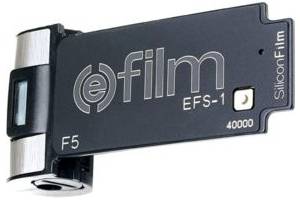
The $699 EFS-1 Electronic Film System consists of three parts. The first is the (e)film cartridge which replaces the film in a Nikon F5, N90 and F3 or Canon EOS 1N, EOS A2 and EOS A5 camera body - it has a resolution of 1.3 megapixels, can store up to 24 images, and has a battery life of up to 300 images per battery set. The (e)film cartridge uses a CMOS image sensor which is smaller than a standard film frame, meaning that it only captures a portion of the area that is seen in the viewfinder, as do most professional digital SLRs which are based on film bodies. This 'focal length multiplier' means that using the (e)film cartridge, you have to multiply the focal length of your lenses by 2.85 to arrive at the effective focal length you'll get when taking digital images. The CMOS sensor and electronics give an ISO rating equivalent to ISO 100, and this cannot be changed...
The next part of the system is the (e)port, which doubles as a protective housing for the delicate (e)film cartridge, and a download device for offloading images. Once you've reached that 24 image limit, or when you need to access your images, you remove the cartridge from the camera, and insert it into the (e)port. You can then either insert the (e)port into a PCMCIA slot in your laptop computer, plug it into a USB port, or plug it into the third and final piece of the system, the (e)box, to offload images and clear space on the cartridge. The (e)box is essentially a converter that allows you to transfer images from the (e)port to a Type-I or Type-II CompactFlash card for downloading your images in the field when you don't have a laptop computer available.
When the EFS-1 system was first announced back in early 1998, it provoked a lot of interest and excitement from readers... Since then, the name of its manufacturer has been changed to Silicon Film from Imagek, and the market has progressed - a lot! In early 1998, cameras of around 1.3 megapixels such as Nikon's Coolpix 900 (now discontinued) were about the pinnacle of what consumers could aspire to. Now, we're rapidly approaching 2001, and three years has brought a lot of change to the marketplace. The first prosumer 4 megapixel camera is already shipping, and it is likely that before long new cameras will be appearing with 4 and even 5 megapixel image sensors... Meanwhile, cameras like Canon's EOS D30 have brought the cost of a digital SLR down to the $3000 range - a price which is only likely to continue to fall. Therein lies the fear for Silicon Film - has the market progressed beyond their product already?
To be sure, the EFS-1 system has its advantages - it is clearly a carefully considered system that covers the whole range between image capture, storage and retrieval. It also allows you to use your existing film camera without modification, along with your existing lenses and accessories, and even to switch back to film should the need arise. This can be a huge attraction, when you've put a huge investment into expensive equipment and lenses! There's no question that at $699, the EFS-1 system is still currently the cheapest way to have an interchangeable lens digital SLR, at least if you don't count the SLR body as part of the cost (if you're considering this system, you probably own the camera body anyway). But it also has its disadvantages:- Very limited storage capacity in-camera
- The need to either purchase multiple (e)film cartridges or potentially miss photos whilst you're offloading images
- The inability to see your images immediately you've taken them, or to delete them without removing the cartridge from the camera
- A fixed ISO rating
- A focal length multiplier that is high even when compared to other available SLR digicams, and will make truly wide-angle photos difficult or impossible, as well as making accurate framing of photos in the viewfinder harder
- Low resolution when compared to current consumer digicams
- High price when compared to current 1.3 megapixel digicams
- Design constraints that make the (e)film cartridge likely easier to break and harder to manufacture than an all-in-one digicam
- Compatibility only with a small choice of SLR film cameras
- No 'frills' like video, sound, histograms, and other features that are available in some consumer cameras
- The need to carry around bulky equipment additional to the camera if you want to be able to shoot more than 24 images, whether it is by offloading images or by using multiple (e)film cartridges
There are also questions that remain unanswered about (e)film - what will the image quality be like? How fast will you be able to take images, or offload them onto your computer or CompactFlash cards... Perhaps the biggest question - is Silicon Film in time, or will the Electronic Film System be something that showed great promise, but arrived too late for the party? It has been getting on for three years since we were receiving excited emails asking about the EFS system - are those potential buyers still excited, or have they already bought a digital camera they're happy with in the meantime? Only time will tell - hopefully this particular story will reach its conclusion soon!
Source: Silicon Film website
Thanks to Mark Fink for this item!

Wednesday, December 13, 2000
Agere demonstrates new flash memory technology!
By Michael Tomkins, The Imaging Resource
(Wednesday, December 13, 2000 - 16:31 EST)
 Researchers at Agere Systems, formerly known as the Microelectronics Group of Lucent Technologies, and the California Institute of Technology have developed a technique that could make memory chips for cellular phones and digital cameras smaller, less expensive and more reliable, according to a press release. Researchers at Agere Systems, formerly known as the Microelectronics Group of Lucent Technologies, and the California Institute of Technology have developed a technique that could make memory chips for cellular phones and digital cameras smaller, less expensive and more reliable, according to a press release.
The research development, announced today at the International Electron Devices Meeting, applies to 'flash' memory - which continues to store information even when the devices are turned off. This information could include personal phone directories in a cellular phone or the pictures captured by a digital camera. In the typical cellular phone, there are 16 to 32 million bits of data stored on a silicon flash memory chip. Each bit of data is stored in a part of the flash memory chip called a 'cell'.
Unlike traditional silicon chips, which continue to double in transistor density every 18 months as dictated by Moore's Law, the design requirements of flash memory present more challenges for continued reduction in size, Agere notes."The concept of today's conventional flash memory cell is very similar to a bathtub," said Agere Systems researcher Jan De Blauwe. "The electrical charge that represents the bit of data typically remains in the tub, but if the tub springs a leak, that charge is lost. And as we try to shrink the size of these conventional tublike cells to make the memory chip smaller, the chance that they'll develop leaks increases. Solutions to this problem exist, but these solutions are increasingly expensive to fabricate, especially since they require the memory cells to operate at higher voltages than today's mainstream chip technology." To overcome the potential leakage problem, De Blauwe and his Agere Systems colleagues, along with Harry A. Atwater and Richard Flagan and their students at Caltech, developed a method to break up each memory cell into 20,000 to 40,000 smaller cells, or 'buckets'. Therefore, even if several of the buckets spring a leak, the vast majority of the charge is not lost and the bit of data stored in the memory cell is retained.
Using an aerosol technique developed at Caltech, the researchers formed the buckets by spraying silicon nanocrystals through a bath of high-temperature oxygen gas. The end result was buckets comprised of silicon on the inside with a silicon dioxide outer shell. The silicon nanocrystal buckets store the electrical charge, whereas the silicon dioxide shell makes the buckets more leak-proof."As compared to conventional flash memories, these silicon nanocrystal memories are easier to fabricate and intrinsically more leak-proof, which could result in lower fabrication costs and lower operating voltages," said De Blauwe.
"We created a hailstorm of silicon nanocrystals, but in this case, the hail was 5 to 10 billionths of a meter, or nanometers, in diameter," said Caltech graduate researcher Michele Ostraat. "The real challenge was getting an even distribution of silicon nanocrystals." The aerosol approach is claimed to have several advantages over conventional lithographic techniques used to make today's flash memory cells. Because it requires fewer steps, it is both less expensive and requires less time. In addition, the aerosol approach will allow researchers to continue making smaller and smaller devices. Currently, because conventional cells, or bathtubs, are becoming more and more difficult to make leak-proof, it is unlikely that their size, and more importantly, their operating voltages, will reduce much further."As the insulating layer on these electrical devices become thinner and thinner, they always are more vulnerable to leaks," said Agere Systems researcher Martin Green. So far, the researchers have created extremely robust flash memory cells. For instance, they have charged and dissipated a single cell one million cycles without significant degradation, whereas 10,000 cycles is considered good. While Agere feels that the research results are promising, the company notes that it is premature to predict if or when the technology will be commercially implemented.
Source: Yahoo! Finance / Business Wire

Yahoo! digital camera now shipping!
By Michael Tomkins, The Imaging Resource
(Wednesday, December 13, 2000 - 15:37 EST)
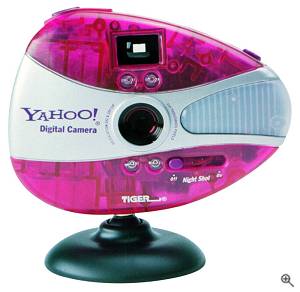
We spotted this afternoon a press release from internet portal Yahoo! Inc. noting that a number of Yahoo!-branded products are now shipping, just in time for the holiday season. Included in the range of products available is the Yahoo! digital camera, actually manufactured by Tiger Electronics. The Yahoo! digicam costs $70 approximately in retail stores, is available in a number of different color schemes (black and silver, blue and yellow, or translucent pink and silver), and has some unusual features compared to other 'toy' digicams... The unusually shaped unit can be used as a tethered video camera, a night camera (infra-red flash and ability to record infra-red light), and a 'spy' camera (detects motion in day or night with built-in motion sensor, and captures still images.
The Yahoo! Digital Camera's built-in memory can capture up to 20 images in CIF (352 x 288) resolution. The unit is PC-compatible only, and operates for 12-16 hours on one set of batteries. It also features a self-timer... No details were available (at least, that we could find) with regards to what connectivity the camera has, or what type of batteries it uses, on Yahoo!'s site. Yahoo! themselves sell the camera for $79.99...

Source: Yahoo! Finance / Business Wire

Tuesday, December 12, 2000
New version of ImageBuddy released!
By Michael Tomkins, The Imaging Resource
(Tuesday, December 12, 2000 - 18:47 EST)
 We received an email from Jeff Thoman of KepMad Systems yesterday, with news that he's released a new version of ImageBuddy, the Macintosh image-viewing/printing application. ImageBuddy v1.1.0 adds manual image layout, support for metric sizes, source image rotation, and the ability to change contact sheet title fonts, as well as adding print status and fixing a number of bugs. We received an email from Jeff Thoman of KepMad Systems yesterday, with news that he's released a new version of ImageBuddy, the Macintosh image-viewing/printing application. ImageBuddy v1.1.0 adds manual image layout, support for metric sizes, source image rotation, and the ability to change contact sheet title fonts, as well as adding print status and fixing a number of bugs.
ImageBuddy is available from the KepMad website and costs $15 to register... The program is for Macintosh only, and there are currently no plans for a Windows version.
Source: ImageBuddy website

New version (v3.24) of Thumber released
By Michael Tomkins, The Imaging Resource
(Tuesday, December 12, 2000 - 18:32 EST)
An email from programmer Max Lyons tells us that a new version of his excellent Thumber 'digital camera swiss army knife' software is now available."I've recently released Thumber 3.24, which is now available for download. In addition to some bug fixes, the latest version adds a couple of useful features:- Bad/stuck Pixel Removal. 'Bad' pixels show up as bright points in images and are caused by defects in the CCD chips used in digital cameras. Thumber can eliminate these bad pixels from images using an 'intelligent' interpolation method.
- Batch Image Processing. This provides the ability to apply one or more image transformation functions (e.g. brighten, resize, increase color saturation, remove bad pixels, etc.) to one or more images in 'batches'. The desired transformations are listed in a text file which Thumber processes for each image to be transformed.
As with all of Thumber's image editing features, any EXIF data and/or comments contained are untouched by these transformations. Detailed instructions on using both new features are included in Thumber's help file."
Source: Thumber web site

Olympus Japan notes E-100RS issues!
By Michael Tomkins, The Imaging Resource
(Tuesday, December 12, 2000 - 18:08 EST)
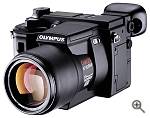 A statement posted on the Olympus Japan website notes a number of issues reported by users of the company's E-100RS digital camera, which is not yet shipping in the US but reached Japanese retail back on November 18th... Our translation of the page reveals that there are apparently three main issues, as follows: A statement posted on the Olympus Japan website notes a number of issues reported by users of the company's E-100RS digital camera, which is not yet shipping in the US but reached Japanese retail back on November 18th... Our translation of the page reveals that there are apparently three main issues, as follows:- Vertical noise banding in images taken at ISO400 and camera set to either
- Shutter speeds of 1/1000 second or faster
- Burst mode of 5, 7.5 or 15 frames per second
- Precapture mode
- Exposure bracketing mode
- White balance bracketing mode
- If the first image of a series taken in:
- Burst mode with or without autofocus (?)
- Exposure bracketing mode
- White balance bracketing mode
- Precapture mode
...is deleted with another camera or computer, other images in the series cannot be displayed by the E-100RS in playback mode - If an E-100RS movie clip is edited in a C-990 Zoom, C-2100 Ultra, C-2040 Zoom, C-3000 Zoom, C-3030-Zoom or C-3040 Zoom digital camera (we presume this would also include the US-equivalent models) using the video editing functionality of those cameras, the movie clip is destroyed.
The usual caveats apply here - we've done our best to translate this page, however the items 2 and 3 in particular were a bit difficult to translate and may not be completely accurate. Olympus USA, only just about to receive its first production models, could not immediately confirm these possible issues for us at the time of this writing, and hence obviously could not advise whether these issues could be corrected before the camera reaches the US market...
Source: Olympus Japan's E-100RS issues statement

Kodak announces DCS 560, 660 holiday promotion!
By Michael Tomkins, The Imaging Resource
(Tuesday, December 12, 2000 - 17:55 EST)
 Eastman Kodak Co. has today distributed a press release noting that "professional photographers can [now] give themselves the holiday gifts they always wanted thanks to an unprecedented holiday promotion for the award-winning Kodak Professional DCS 560 and DCS 660 digital cameras". A promotion offered through Kodak authorized dealers in the United States through December 31 will offer anyone who purchases either a DCS 560 or DCS 660 professional digital Eastman Kodak Co. has today distributed a press release noting that "professional photographers can [now] give themselves the holiday gifts they always wanted thanks to an unprecedented holiday promotion for the award-winning Kodak Professional DCS 560 and DCS 660 digital cameras". A promotion offered through Kodak authorized dealers in the United States through December 31 will offer anyone who purchases either a DCS 560 or DCS 660 professional digital
camera a bonus coupon for $1,000 worth of photographic accessories and/or supplies from authorized Kodak dealers."With this special holiday promotion there's no reason for our customers to end the year without one of Kodak Professional's state-of-the-art digital cameras," said Mike DeWoody, Marketing Manager, Digital Capture, U.S. and Canada, Kodak Professional. "And, with the bonus coupon, photographers have an opportunity to upgrade their digital cameras, improving upon their capabilities even more. Best of all, they can do all this knowing they are not sacrificing quality
for price." Kodak recently announced clearance discounts on several of its discontinued pro digital cameras, the DCS460IR, DCS460c, EOS-DCS 1c, EOS-DCS 1m, NC 2000e Color and NC 2000e Mono. Of these, the only one still in stock is the 1.3 megapixel monochrome NC 2000e Mono, a Nikon N90 based camera currently selling in Kodak's online store for $1000...

iMove Inc. ships SVS-2000 Spherical Video System!
By Michael Tomkins, The Imaging Resource
(Tuesday, December 12, 2000 - 17:26 EST)
iMove Inc. today announced the availability of its SVS-2000 Spherical Video System. The system includes a specialized 6-lens digital camera and post-production software. The predecessor SVS-1000, which we first told you about on August 12, 1999, was designed for and sold to the government for security related applications.
 Spherical video, says iMove, "provides the ultimate viewing experience". Not only can the viewer look all around in 360 degrees, but also up and down. The added field of view, the company feels, creates a feeling of total immersion not available in other panoramic formats. Spherical video, says iMove, "provides the ultimate viewing experience". Not only can the viewer look all around in 360 degrees, but also up and down. The added field of view, the company feels, creates a feeling of total immersion not available in other panoramic formats."Spherical Video is a rich medium with applications in entertainment, security, and corporate visual documentation," says Kermit Yensen, CEO of iMove. "This camera was designed around demanding military and security requirements but is now available for commercial use." 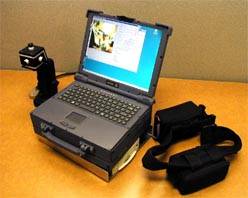
The iMove SVS-2000 is an all-digital, 6-lens camera that captures images in all directions including up and down. In playback, users are able to move forward and backward through the video, at any point looking in any direction. As part of the iMove Multiview Interactive Video family, spherical video also supports embedded hotspots, which can link to data, audio, Web URL's, or branches to other video segments.
Spherical Video can be delivered on CD-ROM, DVD, or via the Internet. It can be viewed on any PC running the Windows operating system. The SVS-2000 camera is designed for field applications. The three-pound camera is connected to a ruggedized laptop computer system. Removable disk storage can hold up to two hours of content, and the system includes a belt battery pack. During postproduction, the images are seamed and compressed into panoramic video frames, which offer the user full navigational control.
Spherical Video content can be distributed over the Internet through iMove's hosting and distribution service. This service includes iMove's RedCarpet streaming support which allows a user to watch and interact with the video while it is being streamed from the Internet.
The iMove SVS-2000 is available for sale for about $75,000. Commercial users can alternatively choose between several leasing options through iMove's alliance with GE Leasing Solutions, and apply on line for a credit decision.
Source: Yahoo! Finance / PR Newswire

Dataquest predicts rapid growth for digital photo kiosks!
By Michael Tomkins, The Imaging Resource
(Tuesday, December 12, 2000 - 16:19 EST)
 A new report from the Gartner Group's market research firm, Dataquest Inc., predicts that photo kiosks will play a key role in the transformation of consumer photography in 2001. By the end of 2000, Dataquest expects digital photographers will be in more than 10 million U.S. households, and as a result, there will be great opportunities for photo kiosk vendors. The worldwide installed base of photo kiosks is projected by the company to double by the end of 2001, reaching 60,000 devices. A new report from the Gartner Group's market research firm, Dataquest Inc., predicts that photo kiosks will play a key role in the transformation of consumer photography in 2001. By the end of 2000, Dataquest expects digital photographers will be in more than 10 million U.S. households, and as a result, there will be great opportunities for photo kiosk vendors. The worldwide installed base of photo kiosks is projected by the company to double by the end of 2001, reaching 60,000 devices.
Photo kiosks have been around for years but have been used mostly to copy photos. The new photo kiosks allow consumers to input digital images or scan photos to print, upload to a Web page or otherwise communicate their photos.
A recent Gartner Dataquest survey showed most digital camera owners are 'very satisfied' with their newest digital camera and are most interested in electronic viewing and simple sharing via email of their digital photos."The most important contribution photo kiosks will make to digital photographers will be to deliver an attractive combination for digital photo printing: high-quality prints at a low cost and within a familiar, convenient environment," said Andrew Johnson, vice president for Gartner Dataquest's worldwide digital document and imaging group. "We believe digital photographers will flock to digital photo kiosks in the near term as an attractive alternative to home printing." In a Gartner Dataquest survey of 1,000 households with digital imaging products, 80 percent of the respondents stated they were aware of the capabilities of photo kiosks, but less than 10 percent had ever used one. As increasing numbers of digital camera owners take more digital photos, the company sees significant latent demand for the high-quality photo output and convenience that kiosks can offer."As kiosk vendors provide easier, more accessible, less expensive ways to print photos, kiosk use will explode," said Andrew Johnson, vice president for Gartner Dataquest's worldwide digital document and imaging group. "Kiosk vendors and their partners will find new profits from on-screen advertising, e-commerce partnerships and breakage from prepaid, stored-value cards." New kiosks from established vendors and new types of kiosks from new vendors are expected to contribute to the market expansion. Kodak has expanded its Picture Maker product line, and Pixel Magic is looking to expand placements of its PhotoDitto and Digital Print Station. New self-contained kiosks from Digital Portal Incorporated (a joint venture between SanDisk and KIS/Photo Me Group) and Gretag as well as terminal-type kiosks from Agfa and Fujifilm that feed digital minilabs will start appearing in stores early next year.
While not yet on the market, the simplicity and low cost of the new online photo upload kiosks could, Dataquest says, drive rapid sales next year. These terminals will be little more than flat-panel touch-screen devices with memory card readers and an Internet connection."Snap-happy consumers can unload their photos and clear their memory cards in a matter of minutes. All financial transactions could happen at the photo Web site, so credit card readers may not be necessary," Mr. Johnson said. "Watch the photo web sites who are partnering with digital camera vendors, especially camera vendors that do not currently have a piece of the photofinishing pie, to be the first out with these units."
Source: Yahoo! Finance / Business Wire

UPDATED: Steve's Digicams posts HP C912 first look!
By Michael Tomkins, The Imaging Resource
(Tuesday, December 12, 2000 - 12:11 EST)
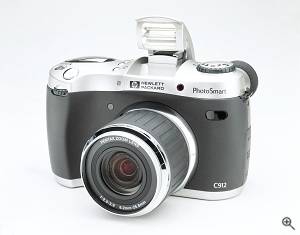
The fine folks over at Steve's Digicams have posted their first-look report on Hewlett Packard's PhotoSmart 912 digital camera, an SLR-style camera which uses a 2/3" 2.24 megapixel frame transfer CCD. There's no conclusions drawn in this first look, nor have the sample photos been posted quite yet, but there's plenty of information on camera layout and control, and numerous close-up photos of the camera itself... Check it out!
Updated 12/12/00 18:23ET:An email from Steve tells us that he's now posted a gallery of 14 images taken with the PhotoSmart 912 digital camera...
Source: Steve's Digicams' HP PhotoSmart 912 first look

DCRP reviews Sony's Mavica MVC-CD1000!
By Michael Tomkins, The Imaging Resource
(Tuesday, December 12, 2000 - 11:02 EST)
 Our friend Jeff Keller over at the Digital Camera Resource Page has now posted his review of Sony's Mavica MVC-CD1000 digital camera... Here's what Jeff had to say on the first digital camera to use CD-R discs for storage: Our friend Jeff Keller over at the Digital Camera Resource Page has now posted his review of Sony's Mavica MVC-CD1000 digital camera... Here's what Jeff had to say on the first digital camera to use CD-R discs for storage:"I want to say up front that I very much like the Sony Mavica MVC-CD1000 for its 'camera features'. It's got a great 10X optical zoom, nice manual controls, good photo quality, and it's easy to use. What I'm not sold on is the CD-R technology itself, as you've probably noticed throughout the review. While it's the cheapest storage out there per megabyte, you lose a lot of the 'digital camera features' such as the ability to truly delete photos, as well as to reuse the storage media. Isn't that why you bought a digicam in the first place? Plus, based on my own problems with the CD-R mechanism, I wonder how long these will last before they really start to have problems. If you're absolutely sold on the CD-R technology, then my concerns probably don't bother you. But it was me shopping for a camera, I'd choose a more traditional camera -- and save some money while I'm at it." For the full story, read Jeff's review of the camera accompanied by numerous sample photos, and a tale of a missing night shot. ;)
When you're done, get second (and more) opinions in our own review, as well as the Steve's Digicams review, that from the Digital Photography Review, and of course the Megapixel.net review (posted in October)...
Source: Digital Camera Resource Page Sony MVC-CD1000 review

Monday, December 11, 2000
Altamira releases Genuine Fractals 2.0 LE to retail!
By Michael Tomkins, The Imaging Resource
(Monday, December 11, 2000 - 20:37 EST)
 Software company Altamira has today announced the introduction of Genuine Fractals 2.0 LE. The new release is a limited version similar to that used by some professional photographers, and is targetted at customers using entry-level digital cameras, scanners, and ink jet printers. Altamira Genuine Fractals 2.0 LE is , says the company, "an excellent companion to the wide range of consumer digital imaging software, such as Adobe Photo Deluxe." Software company Altamira has today announced the introduction of Genuine Fractals 2.0 LE. The new release is a limited version similar to that used by some professional photographers, and is targetted at customers using entry-level digital cameras, scanners, and ink jet printers. Altamira Genuine Fractals 2.0 LE is , says the company, "an excellent companion to the wide range of consumer digital imaging software, such as Adobe Photo Deluxe."
Altamira technology is claimed to allow users to "work with smaller, more agile images, which can be easily transported, stored, or increased in size while maintaining the sharpness of the captured image". Altamira claims that an image from a consumer digital 1.3-megapixel camera, typically suitable for printing a 3 x 4 inch print at 300 dpi, can be acceptably printed at 8 x 10 inches with Genuin Fractals."Genuine Fractals 2.0 LE is the ultimate digital camera accessory," said Bob Goldstein, Altamira's president. "The growing number of consumer-level digital camera owners desire the ability to make high-quality enlargements of their favorite images at home. Our new product provides the solution they demand." Genuine Fractals 2.0 LE is limited to files of up to 10 MB for input and 64 MB output, and is compatible with Adobe Photoshop, PhotoDeluxe, Corel Photo-Paint 9 and Jasc Paint Shop Pro 5.0.3. The program is currently available at Outpost.com, Egghead.com and major software catalogs for $49.95 MSRP.
Source: Yahoo! Finance / Internet Wire

PhotoLoft announces acquisition, change of name!
By Michael Tomkins, The Imaging Resource
(Monday, December 11, 2000 - 17:33 EST)
 Online photofinisher PhotoLoft Inc. today announced that it has signed a definitive agreement to acquire privately held, Los Angeles based Extreme Velocity Group, a provider of Internet and imaging solutions to the art market. Simultaneously, PhotoLoft announced that it would change its name to Brightcube Inc. The Company will begin to trade on the Over-The-Counter Bulletin Board (OTCBB) under the new symbol BRCU today. Online photofinisher PhotoLoft Inc. today announced that it has signed a definitive agreement to acquire privately held, Los Angeles based Extreme Velocity Group, a provider of Internet and imaging solutions to the art market. Simultaneously, PhotoLoft announced that it would change its name to Brightcube Inc. The Company will begin to trade on the Over-The-Counter Bulletin Board (OTCBB) under the new symbol BRCU today.
The combination of PhotoLoft and EVG under the Brightcube name, says the press release, "makes Print on Demand, or the ability to select an individual image, have it delivered to a remote location digitally, and printed at that location on high quality, archival papers and inks, a reality for retailers, photographers, and individual consumers". The acquisition will blend PhotoLoft's online Internet imaging infrastructure technology with EVG's nationwide network of offline brick and mortar art galleries and frame shops, and its proprietary line of inks and paper for digital applications.
In connection with the acquisition, PhotoLoft will issue, in aggregate, approximately 18 million shares of its Common Stock for all of the outstanding capital stock of EVG. In addition, PhotoLoft agreed to pay an $800,000 payable of EVG and assume lines of credit in the aggregate of $690,000. EVG's business model is expected to provide Brightcube with a platform to increase revenues through multiple revenue streams."At EVG I have emphasized revenue and cash flow and will apply the same focus at Brightcube in order to rapidly achieve cash flow breakeven and profitability," comments Al Marco founder and President of EVG. Subject to certain customary closing conditions, the acquisition is expected to close by December 31, 2000. Al Marco will be appointed as the Chief Executive Officer of Brightcube following the closing. The acquisition will be accounted for under purchase accounting.
PhotoLoft notes that Brightcube will "focus on eliminating the inefficiencies associated with standard business practices in the art and photography industry, such as limited distribution resulting in limited choices to consumers, high cost of production and distribution and inventory risks"."The Internet is changing the digital imaging environment at light speed, with the change being led by the rapid growth in digital camera use and the technological advances in inkjet printing. While the greatest growth to date has been in the consumer arena, the professional photographic and art markets are the next frontier. On-demand delivery and printing of images will be a natural result of this," said Terren S. Peizer, Chairman of PhotoLoft. "PhotoLoft was a early participant in the digital imaging infrastructure market, and EVG revolutionized the art world through the creation of an offline brick and mortar network tied together by the Internet. Now, Brightcube - for the first time - will bring together archival quality inks and papers by EVG, extensive photography and art image banks, color/quality management and delivery infrastructure required for Print On Demand to become an industry-preferred method of conducting real-world business."
Source: Yahoo! Finance / Business Wire

Friday, December 8, 2000
Epson recalls reformulated Premium Glossy Photo Paper!
By Michael Tomkins, The Imaging Resource
(Friday, December 8, 2000 - 13:54 EST)
 Epson has posted a notice on its website today noting that it is recalling the initial shipment of its reformulated Premium Glossy Photo Paper, which began shipping in November. The company is adding a label on new packages noting that they shipped in December or later, allowing older packages to be easily identified... Epson has posted a notice on its website today noting that it is recalling the initial shipment of its reformulated Premium Glossy Photo Paper, which began shipping in November. The company is adding a label on new packages noting that they shipped in December or later, allowing older packages to be easily identified...
The initial shipment of reformulated paper apparently may show a powdery residue in dark areas of photographs. If you have purchased any of the affected paper, contact Epson at 562-276-1311 or email the company at [email protected] to have it replaced... A new batch of paper will begin shipping on December 15.
Unfortunately we cannot link directly to the page on Epson's website because of how their site works - to see Epson's announcement you can go to Epson.com, then click on 'Epson Announcements' in the lower left corner of the page, and then click on 'Premium Glossy Photo Paper Update' under the 'Ink Jet Printers' category...
Source: Epson website

Pixami provides photo upload software to PhotoLoft!
By Michael Tomkins, The Imaging Resource
(Friday, December 8, 2000 - 13:01 EST)
 Digital imaging software company Pixami announced today that photo-sharing company PhotoLoft has selected them to supply technology for uploading digital photos. Pixami's Photo Upload technology will allow customers to navigate their hard disk from a web page, view their digital photos, and select single or multiple images for upload to the site. Digital imaging software company Pixami announced today that photo-sharing company PhotoLoft has selected them to supply technology for uploading digital photos. Pixami's Photo Upload technology will allow customers to navigate their hard disk from a web page, view their digital photos, and select single or multiple images for upload to the site."One of the most difficult aspects of many online photo sites is the process of transferring pictures from a home computer to the site. Unfortunately this is also one of the most critical features of the site," said Tom Moore, President and CEO of Pixami. "Photos are the primary revenue source for a photo site -- if a user can't easily upload their photos, they will give up or go elsewhere. This can obviously be very detrimental."
"Pixami's Photo Uploader provides more features, better performance, and is easier to use than any other solution," he added. "We are proud to have been selected by PhotoLoft, and we hope Pixami's technology will add significant value to their already excellent offering."  Pixami's Photo Uploader allows a user to navigate their hard disk for photos to upload to a site. Unlike other solutions, Pixami's Uploader provides thumbnail previews of the user's photos, and allows the transfer of an unlimited number of photos from any number of directories, in a single session. Pixami's Photo Uploader can also be used to upload photos directly from a connected digital camera to the site, bypassing the user's hard disk altogether. PhotoLoft has already integrated this technology into its service for selected partners. Pixami's Photo Uploader is part of a suite of Pixami products designed specifically for online photo sites. Other Pixami products include Editing Tools (red-eye, crop, instant fix, etc.), Special Effects, Textures, Templates (cards, calendars, frames, etc.), and Keepsake Pages (online page layouts). Each of these products is immediately available for integration on a photo site, on either Windows NT or Linux. Pixami is also currently working on multiple new technologies, all designed to meet its company goal of helping photo sites more effectively convert online photos into revenue. Pixami's Photo Uploader allows a user to navigate their hard disk for photos to upload to a site. Unlike other solutions, Pixami's Uploader provides thumbnail previews of the user's photos, and allows the transfer of an unlimited number of photos from any number of directories, in a single session. Pixami's Photo Uploader can also be used to upload photos directly from a connected digital camera to the site, bypassing the user's hard disk altogether. PhotoLoft has already integrated this technology into its service for selected partners. Pixami's Photo Uploader is part of a suite of Pixami products designed specifically for online photo sites. Other Pixami products include Editing Tools (red-eye, crop, instant fix, etc.), Special Effects, Textures, Templates (cards, calendars, frames, etc.), and Keepsake Pages (online page layouts). Each of these products is immediately available for integration on a photo site, on either Windows NT or Linux. Pixami is also currently working on multiple new technologies, all designed to meet its company goal of helping photo sites more effectively convert online photos into revenue.
The first implementation of the Pixami Uploader by PhotoLoft was completed for FutureShop, a PhotoLoft client, and can be viewed at the FutureShop website.
Source: Yahoo! Finance / Business Wire

Thursday, December 7, 2000
PhotoAlley launches Digital Resource Center
By Michael Tomkins, The Imaging Resource
(Thursday, December 7, 2000 - 21:39 EST)
 PhotoAlley.com has in a press release introduces its new Digital Resource Center, where visitors to the Web site can learn about digital photography in three easy steps. PhotoAlley.com's Digital Resource Center provides information on getting started in digital photography (with or without a digital camera), choosing the right equipment, and digital photography tips and techniques. PhotoAlley.com has in a press release introduces its new Digital Resource Center, where visitors to the Web site can learn about digital photography in three easy steps. PhotoAlley.com's Digital Resource Center provides information on getting started in digital photography (with or without a digital camera), choosing the right equipment, and digital photography tips and techniques."PhotoAlley's Digital Resource Center is the perfect Internet stop to make before diving into a digital camera, scanner or printer purchase this holiday season," said Skip Cohen, president of PhotoAlley, Inc. "Getting into digital photography can seem a little overwhelming at times. We created the Digital Resource Center as a complete guide to digital photography by answering the most frequently asked consumer questions about digital photography and by providing a community in which to grow." Within the Digital Resource Center, visitors and members of PhotoAlley.com can learn about digital photographs, creating a digital picture, bringing pictures into the computer, printing digital pictures, e-mail and the Internet, and storing digital pictures. The Digital Resource Center also provides information on choosing the right digital equipment such as digital cameras, as well as computer peripherals like scanners, printers and accessories. PhotoAlley's Digital Resource Center also provides in-depth product reviews for even more information. In the Tips & Techniques section, detailed information on digital shooting tips, digital cameras, scanners, printers, photo software and accessories is provided in cooperation with renowned editorial sources such as Petersen's PHOTOgraphic magazine and Imaging Resource. Consumers can also learn about shooting digital video and how to select the best equipment for their needs.
In addition to educating consumers about digital photography, PhotoAlley.com offers a digital shop featuring a wide range of digital products such as digital cameras, digital camcorders, scanners, memory/image storage, printers and accessories as well as a digital gallery that exhibits the power of digital photography.
Source: Yahoo! Finance / Business Wire

Canon EOS D30 error codes explained!
By Michael Tomkins, The Imaging Resource
(Thursday, December 7, 2000 - 18:45 EST)
 Our friend Uwe Steinmuller over at the Digital Outback Photo website was in touch this morning to let us know that he's posted a list of error codes for the Canon EOS D30 digital camera on his site. Apparently Canon USA's Chuck Westfall provided the codes on Rob Galbraith's EOS D30 forum... If you're lucky enough to own the EOS D30, the list may be helpful to you in troubleshooting a problem that you may well be able to correct yourself quickly. Our friend Uwe Steinmuller over at the Digital Outback Photo website was in touch this morning to let us know that he's posted a list of error codes for the Canon EOS D30 digital camera on his site. Apparently Canon USA's Chuck Westfall provided the codes on Rob Galbraith's EOS D30 forum... If you're lucky enough to own the EOS D30, the list may be helpful to you in troubleshooting a problem that you may well be able to correct yourself quickly.
Source: Canon EOS D30 error code list

Sanyo Japan delays IDC-1000Z launch!
By Michael Tomkins, The Imaging Resource
(Thursday, December 7, 2000 - 18:30 EST)
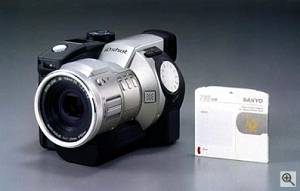
Sanyo Japan has posted an item on its Japanese-language website announcing a delay in the launch of its IDC-1000Z iD-shot digital camera, which is the first camera to store images on 730MB iD PHOTO disks. The camera, initially planned for a December 8th launch, is now scheduled to ship at the beginning of February 2001...
According to our translation of Sanyo's page, and information from our colleagues at Steve's Digicams who first reported this news earlier today, the delay is to allow for more time to test the IDC-1000Z's compatibility with personal computers and other peripherals...
How this will affect the IDC-1000Z's acceptance is unknown - a February launch will see it shipping at about the same time as a new round of digital cameras is likely to be launched at the PMA Spring 2001 show in Orlando, Florida... Sanyo may need to consider reducing the projected $1100 price of the IDC-1000Z, a 1.5 megapixel camera, to account for a more advanced market at that time.
Source: Sanyo IDC-1000Z delay announcement

DPReview posts Kodak DC4800 review!
By Michael Tomkins, The Imaging Resource
(Thursday, December 7, 2000 - 17:21 EST)
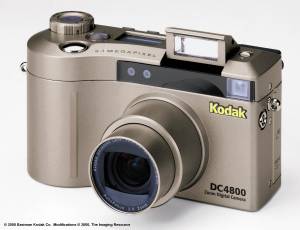
Our friends over at the Digital Photography Review have just posted their review of Kodak's DC4800 digital camera. Here's some of Phil's thoughts:"For Kodak the DC4800 was a radical departure from the DC260/265/290 series which used to be their flagship consumer digital cameras. Its design is far more traditional, yet we still see elements of Kodak innovation in the ergonomics and layout of the camera. There's a lot to like about the DC4800, the wide 28 mm equiv. bottom end, the exposure compensation dial, apertures on the mode dial, the innovative new white balance controls. When it first arrived in the office I really wanted to like the camera.
Certainly there's nothing wrong with the physical layout, nothing too much wrong with the onboard software or processing speed but there are enough factors I wasn't happy with for me to end up with a disappointing feeling about the DC4800." Be sure to check out the full review for the whole story... When you're done, get second opinions from our own review posted back on August 3rd, as well as the Steve's Digicams review, Digital Eye review, and the Digital Camera Resource Page review...
Source: Digital Photography Review Kodak DC4800 review

Wednesday, December 6, 2000
Sanyo licenses Bluetooth for digicams and more!
By Michael Tomkins, The Imaging Resource
(Wednesday, December 6, 2000 - 13:47 EST)
 Tality Corp., a subsidiary of Cadence Design Systems Inc., has announced that Sanyo Semiconductor Co. has licensed Tality's Bluetooth baseband controller silicon intellectual property (SIP) and protocol stack. Tality Corp., a subsidiary of Cadence Design Systems Inc., has announced that Sanyo Semiconductor Co. has licensed Tality's Bluetooth baseband controller silicon intellectual property (SIP) and protocol stack.
Sanyo will first use the SIP in its digital camera chips. These chips can be incorporated in combination with the protocol stack into Sanyo's customers' Bluetooth-enabled digital camera designs. Sanyo will also incorporate Tality's Bluetooth intellectual property (IP) into other semiconductor products, including its application-specific standard IC product line. Tality's IP enables Sanyo to enhance its chips with Bluetooth connectivity.
 Bluetooth connectivity in the digital camera provides cordless communication with PC, printer and phone. A PC can automatically detect the camera and download the photographs, and a mobile phone can download a 'digital postcard' from the camera and transmit it by email. Bluetooth connectivity in the digital camera provides cordless communication with PC, printer and phone. A PC can automatically detect the camera and download the photographs, and a mobile phone can download a 'digital postcard' from the camera and transmit it by email.Said Fumihiro Dasai, General Manager of the System LSI Department for Sanyo's Semiconductor Company. "Enhancing a digital camera with Bluetooth connectivity provides significantly increased flexibility for communicating with a large range of storage, display and communication devices. Adoption of this technology promises to keep Sanyo at the leading edge of digital camera IC design. Licensing Tality's IP gives us a fast-track to Bluetooth connectivity."
Said Brent Hudson, vice president and general manager of Tality's Wireless and Multimedia design group "Licensing Tality's Bluetooth IP gives Sanyo access to a solution used by over a dozen leading companies in competitive consumer and communications markets. Sanyo's skills in high-volume high-technology semiconductor product design and manufacture, coupled with Tality's Bluetooth IP, are a potent combination." The low-power Bluetooth baseband controller SIP implements all real-time Bluetooth protocol functions, and is synthesizable to any target chip fabrication process. The SIP possesses a flexible interface that supports multiple RF communications options.
The upper stack conforms to Bluetooth Host Controller Interface (HCI) specification, and supports all applications profiles currently specified. It can be used in both embedded and hosted applications, and is configurable for different applications. It is designed for the memory-lean environments found in mobile appliances. The lower stack is portable to a wide range of processors, real-time operating systems, Bluetooth baseband chips, and HCI transports.
Source: Yahoo! Finance / Business Wire

Tuesday, December 5, 2000
KB's JamCam 3.0 uses Xilinx Spartan FPGA!
By Michael Tomkins, The Imaging Resource
(Tuesday, December 5, 2000 - 16:14 EST)
 Xilinx Inc. announced today that KB Gear Interactive chose Xilinx Spartan Field Programmable Gate Arrays (FPGAs), instead of an application specific integrated circuit (ASIC), for its JamCam 3.0 digital camera (first announced on May 3rd, 2000). KB Gear selected Xilinx FPGAs based on their affordability and design flexibility, Xilinx says. Xilinx Inc. announced today that KB Gear Interactive chose Xilinx Spartan Field Programmable Gate Arrays (FPGAs), instead of an application specific integrated circuit (ASIC), for its JamCam 3.0 digital camera (first announced on May 3rd, 2000). KB Gear selected Xilinx FPGAs based on their affordability and design flexibility, Xilinx says."In the consumer market, time-to-market is everything," said Jim Triggs, president and chief technology officer of KB Gear. "We wanted JAM CAM 3.0 in stores for the 2000 Christmas season Xilinx FPGAs provided us with a cost effective alternative to an ASIC while cutting months off the development window." 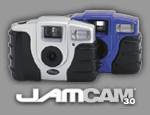 Priced at $99 retail, JamCam 3.0 is distributed by many major department stores and online sites. The digital camera is designed as an affordable way to create digital images and communicate online. Each JamCam 3.0 comes with easy-to-use software and a number of features that can be accessed online at Jamonline.com. The site, hosted by KB Gear, provides users with the ability to store and print digital pictures, download music and quickly and easily develop web sites. Priced at $99 retail, JamCam 3.0 is distributed by many major department stores and online sites. The digital camera is designed as an affordable way to create digital images and communicate online. Each JamCam 3.0 comes with easy-to-use software and a number of features that can be accessed online at Jamonline.com. The site, hosted by KB Gear, provides users with the ability to store and print digital pictures, download music and quickly and easily develop web sites."KB Gear's JamCam is a prime example of Xilinx at work in consumer applications," said Xilinx vice-president of marketing Sandeep Vij. "Our devices are already proving the time-saving advantages that FPGAs bring to the design cycle at price points competitive to an ASIC." The Xilinx Spartan series was created to displace low-end ASICs in volume production by providing the advantages of fast development-to-production time and in-system reprogrammability at competitive prices. Using an advanced process technology, Spartan series FPGAs substantially reduced die size over the previous generation of FPGAs while measurably improving gate density and performance.
Thanks to IR reader David Williford for spotting our unintentional error in this news item, now corrected!
Source: Yahoo! Finance / Internet Wire

Concord Camera allies with Ixla!
By Michael Tomkins, The Imaging Resource
(Tuesday, December 5, 2000 - 15:38 EST)
 IXLA Ltd. and Concord Camera Corp. announced today that they have formed an alliance for the marketing, distribution and sale of still digital cameras. The alliance combines IXLA's imaging and Internet communication software solutions for digital photography with Concord's technology and digital development, design, and manufacturing expertise. IXLA Ltd. and Concord Camera Corp. announced today that they have formed an alliance for the marketing, distribution and sale of still digital cameras. The alliance combines IXLA's imaging and Internet communication software solutions for digital photography with Concord's technology and digital development, design, and manufacturing expertise.
 Under the terms of the alliance, the still digital cameras will be manufactured exclusively by Concord at its ISO 9002 certified manufacturing facility located in the People's Republic of China. The still digital cameras are anticipated to have suggested retail prices from $99 to $149, and will be bundled with IXLA's proprietary digital imaging software packages, providing users with digital photography solutions, from image capture to web page creation and on line image storage. The cameras will feature enhanced VGA resolution and different combinations of features. The cameras will be marketed and sold by Concord's retail sales and distribution business and IXLA through its distribution channels. It is anticipated the products will be shipped to the market during the first half of 2001. Under the terms of the alliance, the still digital cameras will be manufactured exclusively by Concord at its ISO 9002 certified manufacturing facility located in the People's Republic of China. The still digital cameras are anticipated to have suggested retail prices from $99 to $149, and will be bundled with IXLA's proprietary digital imaging software packages, providing users with digital photography solutions, from image capture to web page creation and on line image storage. The cameras will feature enhanced VGA resolution and different combinations of features. The cameras will be marketed and sold by Concord's retail sales and distribution business and IXLA through its distribution channels. It is anticipated the products will be shipped to the market during the first half of 2001.
Commenting on the news, Ira B. Lampert, Chairman, Chief Executive Officer and President of Concord said, "The alliance with IXLA not only confirms Concord's standing and success as a world class original equipment developer, designer and manufacturer of digital image capture and transmission devices, but also the recognition that our retail sales and distribution business can provide opportunities to strengthen our partners retail presence. This is another step in implementing our strategy to partner with leading electronic, Internet, and photography software companies for digital photography, and presents new opportunities for Concord in the Internet arena."
"We see a true synergy partnering IXLA's award winning software products and Concord Cameras leading edge digital image capture devices," said Dr. Soon Teh, IXLA's Chief Executive Officer. "With Concords long history and success in the camera business, this alliance agreement to provide still digital cameras for IXLA's upcoming software product launches, will further support IXLA's decision to focus its core business on software technology development and marketing IXLA software products -- worldwide." Florida-based Concord Camera sells 35mm and APS cameras under the Keystone brand-name as well as OEM manufacturing for companies such as Kodak and KB Gear, whose JamCam 3.0 camera is manufactured by Concord.
Source: Yahoo! Finance / PR Newswire

Kodak Professional gets new President!
By Michael Tomkins, The Imaging Resource
(Tuesday, December 5, 2000 - 15:28 EST)
 Eastman Kodak Company announced today that David L. Swift, Chairman and President of Kodak's Greater Asia Region, has been named President of Kodak Professional, effective February 1, 2001. Patrick T. Siewert, President of Kodak Professional and a Senior Vice President of the company, has resigned to pursue other interests, also effective February 1. Eastman Kodak Company announced today that David L. Swift, Chairman and President of Kodak's Greater Asia Region, has been named President of Kodak Professional, effective February 1, 2001. Patrick T. Siewert, President of Kodak Professional and a Senior Vice President of the company, has resigned to pursue other interests, also effective February 1.
Henri D. Petit was appointed Chairman and President of the Greater Asia Region, effective February 1, which includes Kodak's businesses in China. In September, Petit was appointed Vice Chairman, China. Petit, 52, is a Vice President of the company. Swift, 42 and a Senior Vice President of the company, will report to Martin M. Coyne II, President of Kodak's Commercial Business Group and an Executive Vice President. Lance Drummond remains Chief Operating Officer of Kodak Professional and a corporate Vice President.
Swift returns to Rochester after four years in China, where he began as Vice Chairman of the Greater China Region in January 1997. In September 1997, he was appointed Chairman of the Greater China Region, and in March 1999, he was promoted to Chairman of the Greater Asia Region. During his tenure, Kodak invested more than $1 billion to expand its presence in China, including the establishment of new factories and retail programs. As a result, China is now Kodak's second-largest roll-film market. Swift also established a Digital Product Development Center in Shanghai in 1998 and digital camera manufacturing in that city this year."I have total confidence in Dave as the next leader of Kodak Professional," said Daniel A. Carp, Kodak's President and CEO. "He has demonstrated an ability to drive growth in China, and his team-building skills have put Kodak in position to expand business in Asia for many years to come." Siewert, 45, joined Kodak in 1974, and held positions of increasing responsibility in the company's Consumer, Professional and regional businesses. In 1994, Siewert was named Deputy Chairman of the company's Greater China Region and in 1995 he was elected a company Vice President. Two years later, he became Chairman of the Greater China Region. In July 1997, he was named Chief Operating Officer of Consumer Imaging, and then in November 1997, President of Kodak Professional. Effective January 2000, he was elected a corporate Senior Vice President."For 26 years, Pat Siewert has given his very best to Kodak," Carp said. "He has served this company with grace and integrity. I thank him for all he has done to help Kodak, and for his friendship. I wish him well." Prior to his work in China, Swift was the Chief Operating Officer of the company's Digital & Applied Imaging business unit, beginning in 1995. In the prior two years, Swift served as the assistant to the Chairman, President and CEO. He began his career with Kodak in 1981 as a manufacturing engineer, and has held various positions in product development, strategic planning and product management."In my career, I expect China to become Kodak's largest market for photographic film and equipment," Carp said. "We will continue to invest there because of the exceptional growth potential that exists throughout Asia. The appointment of Henri Petit, a talented executive with broad business and international credentials, to succeed Dave Swift reflects our commitment to increase our customer base in the region."
"While running Greater Asia, Dave was responsible for all of Kodak's businesses in that region," Coyne said. "His experience and knowledge, especially of digital imaging, will help me spread the best practices of each commercial business across the entire group." A native of Wilbraham, Massachusetts, Swift is a graduate of Amherst College and has a Master of Engineering degree in electronics and software from Dartmouth College. He also received a Master's degree in Business Administration from Harvard University in 1989, under the sponsorship of Kodak. "I leave China with our factories up and running, with our market share rising and our investments there paying off as we had hoped," Swift said. "In this new assignment, I look forward to working with the customers and employees of Kodak Professional in our effort to help the business prosper in the digital age." Petit began his career with the company in 1975, when he joined the purchasing division of Kodak-Pathe, the company's French subsidiary. By 1981, Petit was named manager of the photofinishing laboratory of Kodak-Pathe, and in 1985 he became manager of the subsidiary's Business Information Systems and Corporate Accounts. He held a series of management positions before being appointed a corporate vice president in December 1992 and relocating to the U.S. as worldwide general manager of Kodak's Motion Picture and Television Imaging division.
In November 1995, Petit was named general manager for Kodak's Europe, Africa and Middle Eastern Region, and in September 1997, he became the Chief Operating Officer of Consumer Imaging, the company's largest business unit."I am excited by the opportunity to extend Kodak's presence throughout Asia," Petit said. "Kodak is just beginning to reap the benefit of our investment in the region, and it is my good fortune to be assigned the responsibility of building on our success." A native of Baden-Baden, Germany, Petit holds a Master's degree in engineering from the Ecole Superieure de Physique et Chimie de Paris, a post-graduate degree in nuclear physics, and a Ph.D in corpuscular electronics from the University of Paris XI, France. He attended the Advanced Management Program, I.N.S.E.A.D., Fontainbleau, France.
Source: Yahoo! Finance / Business Wire

New version of Qimage Pro released!
By Michael Tomkins, The Imaging Resource
(Tuesday, December 5, 2000 - 15:17 EST)
 We spotted this morning that Mike Chaney, author of the excellent Qimage Pro image viewing/printing/editing application yesterday released a minor update. Qimage Pro v10.3 has the following updates: We spotted this morning that Mike Chaney, author of the excellent Qimage Pro image viewing/printing/editing application yesterday released a minor update. Qimage Pro v10.3 has the following updates:- Higher resolution prints: Qimage Pro v10.3 now offers a new "maximum quality" option that uses the high quality interpolation methods offered by Qimage Pro to send prints to your printer at your printer's native resolution (DPI). The new "maximum quality" option take a bit longer to print, but will result in higher quality prints. The default resolution is "High" but can be changed to the new "Maximum" level when micro detail is important and your prints must withstand scrutiny under very close examination.
- New interpolation options: The new print interpolation options are less confusing, but offer a bit less control than previous versions. Since Qimage Pro now takes direct control of all your prints by using higher quality interpolation methods, there is no longer any need to set print interpolation thresholds. Now, you need only set the print quality level using "Options", "Print Interpolation". Prior versions needed a threshold because the image first needed to be interpolated before it was "stretched" by the print driver to the appropriate size on the printed page. Qimage Pro v10.3 now performs only one internal "stretch" operation using higher quality interpolation methods, rather than allowing the print driver to do the final sizing. This "single stretch" offers higher quality output than the older "two stretch" operations since data only needs to be manipulated once. The new "single stretch" method therefore requires no selection of an interpolation threhold since all data goes through the interpolator up front.
- Numerous additions to color management to make life easier: Realizing that some of the new options regarding color management can be confusing, we have added many new features that will assist you in always knowing how your color is being managed. For example, if you have set up some ICM files for your camera(s) under "Options", "Color Management" and you found yourself wondering if the associations were really working prior to print time, you need wonder no more. Just add the image(s) to the queue and the ICC profile that is "tagged" to each image will be displayed next to the image names in the queue. Further verification of printer and monitor settings is displayed in the "Queue Actions" tab so that you can confirm these important settings prior to print/display.
- Bug fixes: We also corrected some minor bugs such as the monitor ICC profile not always being applied while in the batch filter, NEF Options not working from the image examiner, etc.
Source: Qimage Pro website

Digital Portal Inc. to use Kingnet remote management!
By Michael Tomkins, The Imaging Resource
(Tuesday, December 5, 2000 - 15:11 EST)
KING Products Inc. announced today that it has signed a contract with Digital Portal Inc. to provide its software platform on DPI kiosks. KING will also host the servers from Toronto.
Digital Portal Inc. is a joint venture between Sandisk Corp. and PhotoMe Int'l., the largest operator of photo booths in the world with more than 27,000 sites in operation. Digital Portal Inc. will install in the United States up to 10,000 digital photo kiosks, allowing digital camera owners to print on photo paper and to free their CompactFlash memory cards, uploading them into a storage server.
KING has developed technology to manage large networks of interactive multimedia terminals. DPI has selected Kingnet to remotely manage its terminals from a central server. Kingnet will give permanent online information about the kiosks, reduce maintenance costs and automatically update content. KING will also provide its King Payment System software to allow credit and debit card processing online.
Bertrand Meis, President and CEO of King Products said: "This is a major breakthrough for KING technology. Our solution is now powerful enough to attract other kiosk companies. I am very pleased to team up with Sandisk and PMI in this very innovative technology which will bring high value to the public. By hosting the system at KING, we are moving successfully to the service market."
Source: Yahoo! Finance / Canada NewsWire

Polaroid, CMD announce strategic alliance!
By Michael Tomkins, The Imaging Resource
(Tuesday, December 5, 2000 - 14:56 EST)
 Polaroid Corp. today announced a strategic alliance with Colorado MicroDisplay Inc. (CMD) to develop and market a new generation of mobile, wireless digital imaging and printing devices based on advanced area array technology. The press release notes that research will "focus on bringing the consumer and commercial marketplaces solutions that feature improved image size, higher resolution displays and print options using Polaroid's existing and advanced media." Polaroid Corp. today announced a strategic alliance with Colorado MicroDisplay Inc. (CMD) to develop and market a new generation of mobile, wireless digital imaging and printing devices based on advanced area array technology. The press release notes that research will "focus on bringing the consumer and commercial marketplaces solutions that feature improved image size, higher resolution displays and print options using Polaroid's existing and advanced media.""This alliance represents a key step in executing the Polaroid digital strategy. It combines the resources of both companies to realize the tremendous potential of advanced area array technology for new digital imaging platforms that will allow picture taking and printing anytime, anywhere," said Gary T. DiCamillo, Polaroid chairman and chief executive officer. Utilizing CMD's microdisplay technology, Polaroid plans to create mobile, wireless, low-cost products that will generate multiple copies of digital images instantly and without the hassle of uploading them to a computer or website.
Kenney R. Roberts, president and chief operating officer of CMD, noted that CMD's area array technology has created microdisplays that Polaroid feels generate faster and improved digital images and use significantly less energy than traditional systems."CMD and Polaroid will be jointly developing creative ways to bring customers digital imaging products with easy-to-view LCDs and extended battery life," Roberts said. The alliance also covers a range of secondary applications, including the use of miniature, embedded-LCD viewfinders for digital cameras to solve the top two problems that plague most digital cameras - electronic LCDs that drain batteries after just a few minutes and that are almost impossible to see in bright sunlight."CMD microdisplays produce larger, brighter and higher resolution images than standard LCDs found on today's digital cameras. They deliver a 14-inch image versus a 1.8-inch image, three times the resolution, and eliminate the pixelation normally associated with camera monitors. Microdisplay-based viewfinders are not impacted by sunlight and, because they require less power, they extend the life of the camera's batteries," Roberts said. Judith G. Boynton, Polaroid's executive vice president, business development, and chief financial officer, noted that the relationship between Polaroid and CMD involves more than research and development of new products."Polaroid recently took an equity position in CMD joining several other prominent companies in the most recent round of financing. And John L. Puckett, Polaroid's vice president and general manager - wireless and internet technologies, serves as an advisor to CMD's board of directors," she said. Boynton said that the strategic alliance complements an already strong presence that Polaroid maintains in the digital camera market."We saw more than 30 percent growth in digital camera sales behind a nearly four-fold increase in digital camera unit sales in the third quarter of this year compared to the same quarter last year," she said. Polaroid continues to hold a category-leading 42 percent share of digital camera volume sold in U.S. Food, Drug and Mass Merchandising outlets, according to data from Information Resources, Inc. (IRI) for the most recent 13-week period.
Source: Yahoo! Finance / PR Newswire

Agilent, Flashpoint offer Digita camera designs!
By Michael Tomkins, The Imaging Resource
(Tuesday, December 5, 2000 - 13:17 EST)
 Agilent Technologies Inc. and FlashPoint Technology Inc., the creator of Digita, the industry standard technology for digital imaging, will announce tomorrow that the two companies will jointly market a series of complete digital camera designs based on the Agilent HDCP-3200 camera controller chip and FlashPoint's Digita operating system. Agilent Technologies Inc. and FlashPoint Technology Inc., the creator of Digita, the industry standard technology for digital imaging, will announce tomorrow that the two companies will jointly market a series of complete digital camera designs based on the Agilent HDCP-3200 camera controller chip and FlashPoint's Digita operating system.
 The arrangement is designed to lower the cost of development and decrease the time to market for new digital cameras, as manufacturers are provided with a complete and compatible design including the image sensor, image processor, control chip and control software. The arrangement is designed to lower the cost of development and decrease the time to market for new digital cameras, as manufacturers are provided with a complete and compatible design including the image sensor, image processor, control chip and control software."With these designs, Agilent and FlashPoint will help manufacturers to deliver high-performance, cost-effective still cameras to market in less time," said Stephen Saylor, president of FlashPoint. "Camera manufacturers face increasing pressures to deliver new models to the market. We can help them meet their goals by providing a modular, high-performance solution that cuts down on engineering and development costs."
"We're providing pre-engineered software drivers and interfaces, backed by a world-class design support team," said Jason Hartlove, business unit manager of Agilent's Imaging Electronics Division. "Our customers will be able to beat their competition in rapid deployment of a series of high-perfo rmance cameras into the market, reducing their development time significantly."

Monday, December 4, 2000
DPReview posts Olympus C-2100 review!
By Michael Tomkins, The Imaging Resource
(Monday, December 4, 2000 - 15:21 EST)
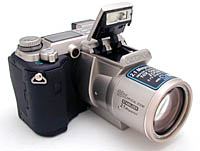 Our friends over at the Digital Photography Review website have posted their review of Olympus' C-2100 UltraZoom digital camera. Here's Phil's feelings: Our friends over at the Digital Photography Review website have posted their review of Olympus' C-2100 UltraZoom digital camera. Here's Phil's feelings:"If you need a long zoom and aren't bothered by the 2 megapixel sensor then the C-2100UZ is a very logical camera to have near (if not at the) top of your buying list. If you consider what you'd have to do to get 380mm of zoom out of any other digital camera or a digital SLR it's amazing to consider how compact and light the C-2100UZ really is, the lens works well, a hint of chromatics at long zooms is to be expected but on the whole doesn't detract. The image stabilisation works well and definitely gives you a stop or two over what you'd normally be able to handhold." Check out the full review, and then get second (and more) opinions from our own review, along with the Steve's Digicams review, Digital Eye review, digitalkamera.de review and finally the Digital Camera Resource Page review! (Now that's a lot of opinions!) :)
Source: Digital Photography Review Olympus C-2100 UltraZoom review

Digital Eye posts Fuji FinePix 4900 review!
By Michael Tomkins, The Imaging Resource
(Monday, December 4, 2000 - 11:18 EST)
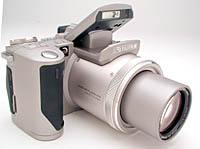 It seems to be the Fuji FinePix 4900's day in the spotlight today - no sooner had we posted a link to the Digital Camera Resource Page's review of this interesting camera, than we read an email from our friends over at the Digital Eye website letting us know that they too had reviewed it! Here's David Kamanski's thoughts condensed: It seems to be the Fuji FinePix 4900's day in the spotlight today - no sooner had we posted a link to the Digital Camera Resource Page's review of this interesting camera, than we read an email from our friends over at the Digital Eye website letting us know that they too had reviewed it! Here's David Kamanski's thoughts condensed:"With what is clearly a very good and larger than normal 6X optical zoom lens, full manual controls, compact lightweight design and excellent color results, we feel the Fujifilm FinePix 4900 Zoom has a lot going for it at a price range under $1,000 dollars. It compares favorably with the top 3 megapixel camera, with resolution just slightly lower, but with a better optical zoom making it a good choice for those who prefer a greater zoom range." There's also two image galleries accompanying the review - one shot at Disneyland, and the other at Legoland...
Source: Digital Eye's Fuji FinePix 4900 review

DCRP posts Fuji 4900, Handspring eyemodule reviews!
By Michael Tomkins, The Imaging Resource
(Monday, December 4, 2000 - 10:54 EST)
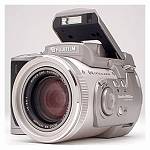 The good folks over at the Digital Camera Resource Page have posted two new reviews on their site this morning... First up is a look at Fuji's FinePix 4900 Zoom digital camera: The good folks over at the Digital Camera Resource Page have posted two new reviews on their site this morning... First up is a look at Fuji's FinePix 4900 Zoom digital camera:"The Fuji FinePix 4900 Zoom is a full-featured, capable camera that can be enjoyed by beginners and pros alike. The 6X optical zoom really comes in handy sometimes (see the tiger picture in the gallery for a good example) -- it really overpowers the standard 3X zoom of most cameras. The camera is also one of the fastest out there, with minimal processing times. The build quality is very good, and the camera includes an attractive bundle." There's also a review of the eyemodule digital camera for the Handspring Visor palm PC:"[Regardless] of its limitations, it's a fun module. The eyemodule is definitely worth the price for the quick snapshots you can shoot on the go at a fraction of the size and weight of a normal digital camera."

Saturday, December 2, 2000
MASSIVE Comparometer(tm) update!
By Michael Tomkins, The Imaging Resource
(Saturday, December 2, 2000 - 13:00 EST)
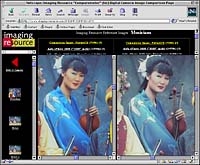 This actually happened a week ago, we're only just now letting everyone know about it: With some background work we've been doing, our Comparometer(tm) test image comparison tool got badly out of date. We've now updated it to include ALL reviewed cameras, with the sole exception of the FinePix 1300 below, which should be posted by sometime Monday. The Comparometer(tm) remains the only place on the web where you can compare 9 different standardized test images shot with a hundred different digicams side by side. We also encourage you to download our test shots and print them out (for personal use only!) on your own photo printer, so you can see exactly how the different cameras compare when viewing actual prints. - Not to mention, of course, the actual photographic print samples we have available for selected cameras through Ofoto. - See our Print Samples page. (link removed as this offer doesn't exist any more, 2005/06/30) This actually happened a week ago, we're only just now letting everyone know about it: With some background work we've been doing, our Comparometer(tm) test image comparison tool got badly out of date. We've now updated it to include ALL reviewed cameras, with the sole exception of the FinePix 1300 below, which should be posted by sometime Monday. The Comparometer(tm) remains the only place on the web where you can compare 9 different standardized test images shot with a hundred different digicams side by side. We also encourage you to download our test shots and print them out (for personal use only!) on your own photo printer, so you can see exactly how the different cameras compare when viewing actual prints. - Not to mention, of course, the actual photographic print samples we have available for selected cameras through Ofoto. - See our Print Samples page. (link removed as this offer doesn't exist any more, 2005/06/30)
Source: The Imaging Resource Comparometer(tm)

Full review of Fuji FinePix 1300!
By Michael Tomkins, The Imaging Resource
(Saturday, December 2, 2000 - 12:57 EST)
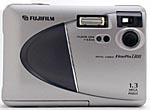 Our second review posting today is also for a Fujifilm product, the FinePix 1300. This is an entry-level 1.3 megapixel camera, good for making sharp prints up to about 5x7 in size. This is an upgrade to Fuji's previous MX-1200, the major difference being that the F1300 sports a USB interface for much faster image downloads. Good image quality, decent exposure control, and a simple interface. Pretty compact too: A nice entry-level camera for someone wanting enough resolution for good prints, but not a lot of complexity in the user interface. Check it out! Our second review posting today is also for a Fujifilm product, the FinePix 1300. This is an entry-level 1.3 megapixel camera, good for making sharp prints up to about 5x7 in size. This is an upgrade to Fuji's previous MX-1200, the major difference being that the F1300 sports a USB interface for much faster image downloads. Good image quality, decent exposure control, and a simple interface. Pretty compact too: A nice entry-level camera for someone wanting enough resolution for good prints, but not a lot of complexity in the user interface. Check it out!
Source: Imaging Resource Fuji FinePix 1300 review

Full review of Fuji FinePix 2400!
By Michael Tomkins, The Imaging Resource
(Saturday, December 2, 2000 - 12:15 EST)
 We're finally getting back on track with the review work after the double-hit of Comdex and Thanskgiving. Today, we're leading off with the full review of Fuji's value-leading FinePix 2400. This is a 2 megapixel update of the sleek little 1.3 megapixel FinePix 1400 that we reviewed previously. The new unit is pretty much identical to the earlier design, only with a 2 megapixel sensor. The bottom line is a very affordable (we've heard of "street" prices as low as $349!) 2 megapixel digicam with a true 3x optical zoom lens and very good picture quality. Read the review for all the details! We're finally getting back on track with the review work after the double-hit of Comdex and Thanskgiving. Today, we're leading off with the full review of Fuji's value-leading FinePix 2400. This is a 2 megapixel update of the sleek little 1.3 megapixel FinePix 1400 that we reviewed previously. The new unit is pretty much identical to the earlier design, only with a 2 megapixel sensor. The bottom line is a very affordable (we've heard of "street" prices as low as $349!) 2 megapixel digicam with a true 3x optical zoom lens and very good picture quality. Read the review for all the details!
Source: Imaging Resource Fuji FinePix 2400 review

Kodak posts DC4800 firmware update!
By Michael Tomkins, The Imaging Resource
(Saturday, December 2, 2000 - 12:08 EST)
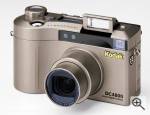 IR reader (and regular contributor) Rommel P. Feria emailed us last night with news that Kodak has released a new firmware update for its DC4800 digital camera. Firmware version 1.04 has the following updates, according to Kodak: IR reader (and regular contributor) Rommel P. Feria emailed us last night with news that Kodak has released a new firmware update for its DC4800 digital camera. Firmware version 1.04 has the following updates, according to Kodak:- Improved Auto Focus (AF) in dim lighting situations
- Alarms if not in AF range
- Displaying Landscape/Closeup icon and Exposure Compensation icon on color LCD screen
PTP (Picture Transfer Protocol) improvements (For future compatibility)- Minor bug fixes (unspecified)
The firmware update can be done with either a Macintosh or IBM PC compatible computer, or via the flash card, as per Kodak's instructions. We strongly recommend readers to follow Kodak's instructions to the letter, and only to upgrade if you've been experiencing problems or need any of the additional updates. Firmware updates, whilst usually reliable if you follow the instructions, can be a great method of turning your digital camera into a very expensive paperweight! :)
Thanks to Rommel P. Feria for this item!

Friday, December 1, 2000
Megapixel December issue online!
By Michael Tomkins, The Imaging Resource
(Friday, December 1, 2000 - 12:49 EST)
 Our friends over at the bilingual Megapixel.net website have now posted their December issue... Reviews this month include the Olympus Camedia E-10, Fujifilm FinePix 4900, Fujifilm FinePix 2400 and Hewlett-Packard C912 digital cameras. There's also an article describing why digital camera lenses are often quoted in terms of a "35mm equivalent", the third part of a beginner's guide to digital cameras, and a gallery of Macro and Close-up photos. Our friends over at the bilingual Megapixel.net website have now posted their December issue... Reviews this month include the Olympus Camedia E-10, Fujifilm FinePix 4900, Fujifilm FinePix 2400 and Hewlett-Packard C912 digital cameras. There's also an article describing why digital camera lenses are often quoted in terms of a "35mm equivalent", the third part of a beginner's guide to digital cameras, and a gallery of Macro and Close-up photos.
Source: Megapixel.net

Digital Eye Comdex report posted!
By Michael Tomkins, The Imaging Resource
(Friday, December 1, 2000 - 10:51 EST)
Checking around our fellow digital photography sites, we spotted that our good friend David Kamanski of the Digital Eye website was also at Comdex Fall 2000, and has posted a report of what he saw, as well as a gallery of Comdex photos taken with the Coolpix 880, a gallery of Sony's booth taken with the Epson PhotoPC 3000Z, and a gallery of Las Vegas photos taken with the Coolpix 880.
When you've finished reading all this, if you've not already read our own Comdex coverage, check it out too! :)
Source: Digital Eye Comdex report


AOL Alert: Several readers connecting
via AOL have complained of poor image quality when using the AOL web browser.
This is caused by a setting called "compress images" in the browser
that causes it to completely mangle images in the interest of faster transmission.
You should turn this setting OFF before viewing any of the comparison images
on this site.
- FLASH: Thanks to reader Lynn Mannan, here's an explanation of how to
make the correct settings adjustments (at least in AOL 4.0 for PCs):

- I opened the "My AOL" preferences screen
in the toolbar across the top. Then I clicked on WWW icon and selected
the "web graphics" tab where I unchecked the "compressed
graphics" choice and clicked on the Apply button at the bottom. Now
the scanner test pictures are gorgeous. The pictures take a long time to
load. But they are worth waiting for. Thank
you, Lynn!
|
 |